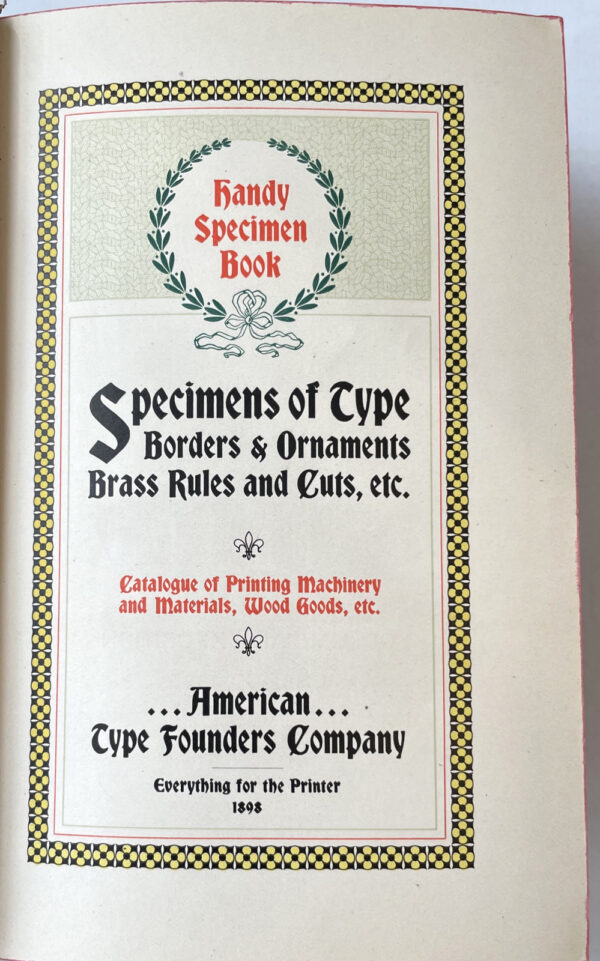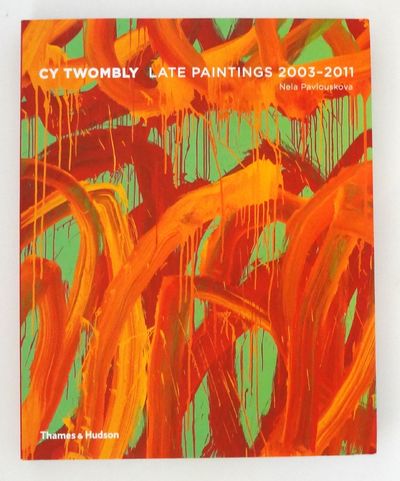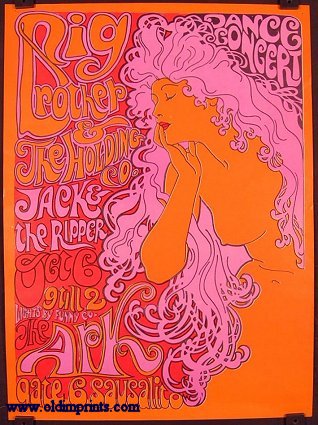
Dorothy Lamour’s Life as a Phrase Book
Janaczewska, Noëlle 13 x 18. A concertina of 11 triple gate-fold pages, which unfold to about 16 feet. Designed by Mike Hudson in a variety of type faces and illustrated with his multi-colored linocuts, additionally hand colored. There is a sheet of instructions on opening/ viewing the pages. Laid into a colorful pictorial cloth box. Fine copy of a fun book. The book is a typographic rendition of Janaczewska's play, in which actress finds herself in a poem instead of a movie, and marooned in a dingy Sydney hotel. To maintain the spirit of a performance, the book has a theatrical setting. Jarvis explains "the hotel room which appears on every one of the 11 gate-fold pages, was Dorothy's stage. Onto this stage various scenarios obliquely suggested by the text were introduced . a chessboard, a maze, a giant pineapple, a clapperboard and an overweight Ronald McDonald." Production required two years. Jadwiga Jarvis, the printer, wrote that the book "will stand as a testimony to what can be achieved by a private press -- providing its proprietors are on a suicide mission." No. 20 of 30 signed copies. The Wayzgoose Press (1985 - 2021) of Michael Hudson and Jadwiga Jarvis was "a fiercely independent, reclusive private press operating from the depths of Katoomba in the Blue Mountains of New South Wales, and its output was extraordinary by anyone's standards. They combined their individual professional design skills with techniques such as handset letterpress, wood engraving, linocut, photography, craft bookbinding and calligraphy.- $8,050
- $8,050

Tell A Tall Tale
Salisbury, Kent (Author), Zanazanian, Adrina (Illustrator) Tall plastic comb bound 15 3/4" by 6 1/2" Cardboard covers. Consisting of six groups of six cardboard panels, each with text by Kent Salisbury and a color illustration by Adrina Zanazanian which can be turned and combined to make thousands of different stories. Spine of plastic comb separated in places but binding functionally. Light shelf wear to covers- $125
- $125
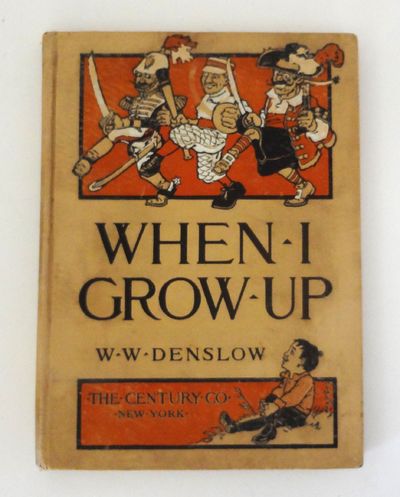
When I Grow Up
Denslow W.W. New York, 1909 First edition, September 1909. Hard cover. Large octavo, 9 7/8" by 7 3/8". Tan cloth with cover and spine decorated in black, white and orange. Unpaginated but 104pp. 24 full page color drawings and 24 full page monochrome drawings by Denslow. Short handwritten inscription to front free and paper dated 1914. Light rubbing to covers with some marks, heavier to spine. Illustrations sharp and bright. The book comprises 24 different types of people a child could be when they grow up, with a poem and illustrations for each by W.W. Denslow, who is best remembered as the original illustrator of "The Wonderful Wizard of Oz" by L. Frank Baum.- $500
- $500
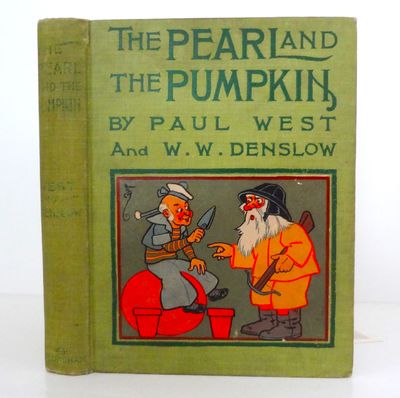
The Pearl and the Pumpkin
Paul West and W.W. Denslow New York, 1904 Hard cover. Large octavo. [ii] 240 pages. Light green cloth Stamped in dark with pictorial label in color to front. Sixteen color plates and numerous two-color illustrations by Denslow. Gift inscription to header of page 7. Spine a little rubbed else a fairly bright copy. Very good. This fantasy was originally conceived as a stage musical with the book as an accompaniment. The play opened in Chicago in 1905 but did not run for long despite Denslow's costumes and elaborate sets receiving much praise. Denslow is best known as the original illustrator of "The Wonderful Wizard of Oz" by L. Frank Baum.- $160
- $160
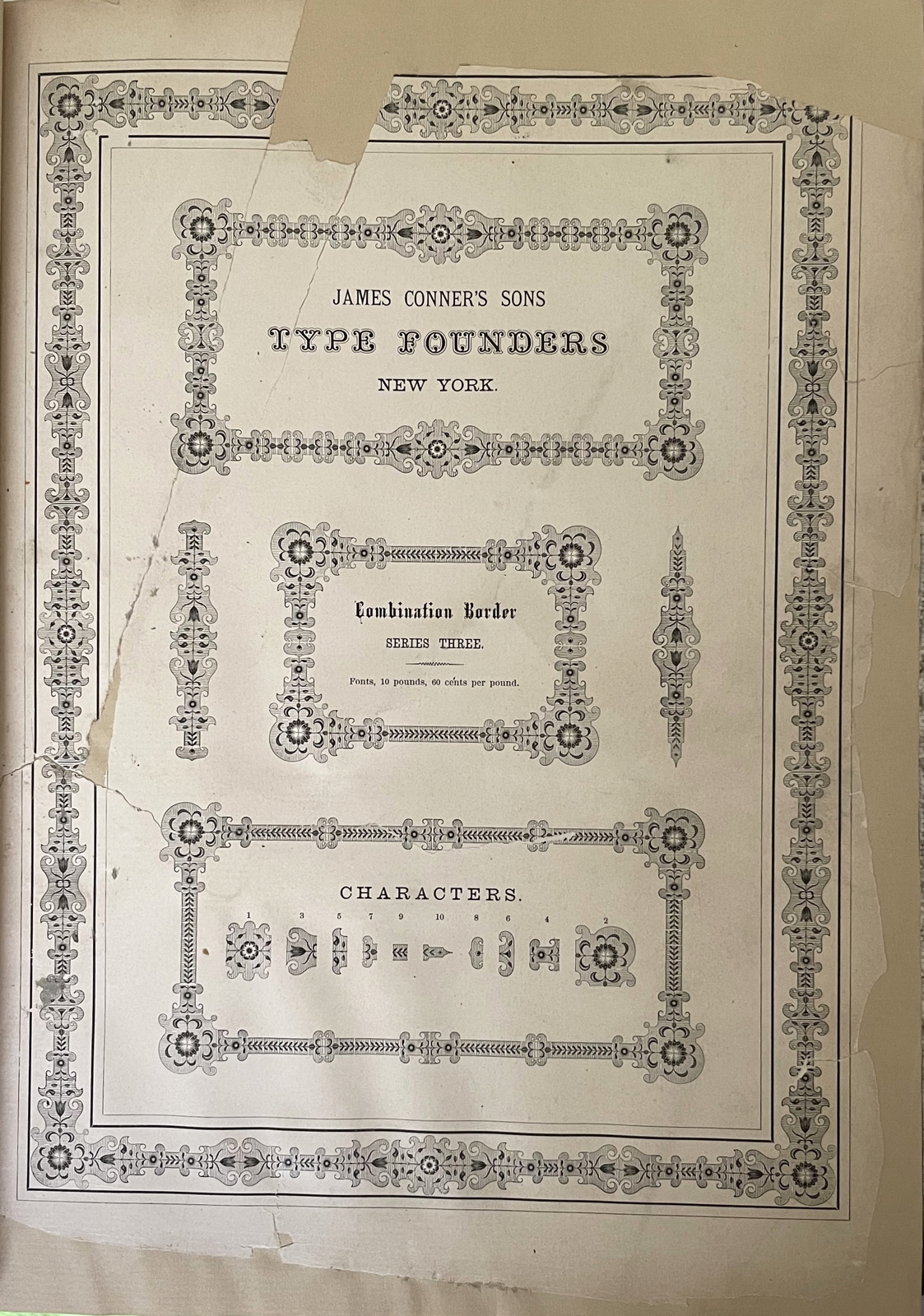
(A SPECIMEN OF ORNAMENTAL MATERIAL & CUTS)
Connor's, James Sons Typefounders. 9 3/4 x 12 3/4. About 195 leaves printed on one side (rectos) only. No title page. The first 78 leaves are not numbered. They display combination borders. There is some color printing. Several leaves are chipped or clipped and are mounted one leaf has been removed. Electrocuts comprise the second part. It is numbered 1 to 123 but is missing at least 7 leaves. It also has chips & tears. Internal condition is "good." Rebound in black cloth & marbled endpapers.- $575
- $575
![Kyuba Shinron. [A New Theory on Raising Horses]](https://rarebookinsider.com/wp-content/uploads/2023/07/31433036517-600x509.jpg)
Kyuba Shinron. [A New Theory on Raising Horses]
Ryuzando Shujin Japan: Suharaya, and others, Kaei 7 (1854). Fascinating and scarce account of a samurai's son whose personal determination led him to rise above the family's financial poverty, to properly care for his horse, build his own stables, and breed additional horses, all by learning the ancient long-forgotten ways of the ancient samurai. 8vo. 1 volume, 78 pages, including 9 full-page illustrations, two of which are hand coloured. Woodblock print. All text is in Japanese. Postscript records the first edition being published in 1806. Traditional karitoji paper binding string-stitched at spine, fukurotoji style ("bound-pocket" with folded leafs bound into spine), and opening from left to right. Natural paper covers, with manuscript title label to front. Together the volumes measure approximately 18 x 25,5 x 1 cm. Negligible creasing to boards and age-toning to upper margins, otherwise in very good and original condition, a pleasing and uncommon work. Based primarily on contemporary descriptions of the financial distress felt by the long-standing prestigious samurai class, such as the present account, it is accepted, without dissent that the ruling samurai class suffered increasing poverty during the Tokugawa (Edo) period. Seifu Murata (1746-1811) wrote: "For years now, the samurai have suffered from poverty and their minds have been occupied by making a living. Buy this, sell that and pawn this to pay for that has become all of their lives. Even for those dedicated to their duties, it was inevitable to debase themselves and to engage in unsavory conduct (i.e., engage in trading)". Even the wives of those who were earning as much as 200 koku busied themselves in trading and in shops. This is the hero's journey, imparted firsthand, of a brilliant young samurai born into poverty but wide-eyed and unrelentingly in pursuit of mastering the skills of a samurai and honouring his destined status in this class of nobility. Young Ryuzando Shujin began by learning the equestrian warrior traditions with a borrowed horse, and was eventually able to convince his father to buy him a horse of his own, despite of the family's economic situation. When the cost of caring for the horse became a burden no longer bearable, and he was told the horse would be sold, he fixated on finding a solution. Immediately, he began conducting extensive research into the ancient methods employed when most samurai were farmers who held the role of warrior in the event of a battle. The solution to combating the costs was breeding and selling. He began the process, while being scrutinized, mocked and judged by others, in particular jeering his rudimentary (cost-effective) hand-made stables. But he did not let any outside opinions pierce his confidence. After repeated trial and error, it was not long that he possessed six horses. Surely too, he had solved the challenges of the household finances. Shujin championed horsemanship as a duty of all samurai. With the belief that all samurai should therefore possess their own horse, in part to best perform archery, spearmanship, and swordsmanship, and owing to the fact that this was an era where some samurai families were poor, he published his methods for others to follow, and ultimately uphold their rights and responsibilities that their title suggests. The volume includes instructions for building horse stables by hand, without incurring high costs. He describes the breeding process, his training methodology, and proper feeding. His own experiences with horses falling to sickness and how he treated them back to health are also shared. Clearly a man with a charitable and honest heart, he concludes by stating that all of this aside, the single most important thing for a healthy and happy horse is "aishin" (affection).- $975
- $975

Manuscript “Private” Account of the Grand Russian Fleet Review Held From 13 to 25 August 1897 in Krasnoye Selo.
Wilfred Seymour - Czar Nicholas II of Russia Manuscript "private" account contemporary to, and describing firsthand, the Grand Russian Fleet Review held from 13 to 25 August 1897 in Krasnoye Selo, by Wilfred Seymour who received a personal invitation to the event, who met and conversed with Czar Nicholas II, and who had fought against Russia in th Crimean War formerly being attached to the Coldstream Guards. 8vo. 7 pages in manuscript on two double leafs, blue paper watermarked "Joynson 1865" measuring approximately 18,5 x 23 cm, dated and initialed by the writer. Together with a manuscript letter also by Wilfred Seymour, written only a few days before, 11 August 1897, while on the steam yacht "Tighnamara" making the voyage to Saint Petersburg for the Presidential celebrations, so mentioned in the text. 8vo. Double leaf ivory paper measuring 13 x 21,5 cm, signed by the writer. Very good condition, a singular primary source "private" account with excellent content. A significant event in Russia's history, of which there is very little documentation, is preserved with remarkable firsthand details, not from a distant observer, but rather from a well-connected Englishman who had a privileged invitation by the Russian Court and who spoke with the Emperor in person during the ceremonies. The event described in these papers marks a most interesting time of Russian relations with European powers, a Franco-Russian Alliance having been established with agreements made from 1891 to 1893 though not officially announced until the conclusion of these ceremonies. At the same time, Anglo-Russian relations were tenuous, the two nations having been rivals for most of the nineteenth century especially in the Crimean War and the Great Game, and just at the time of the Imperial Fleet Review were settling into diplomacy. Within two years of this event, the two would cooperate and join others to protect their interests in China during the Boxer Rebellion. Attending the "Grand Review of Troops" held at Krasnoye Selo, Wilfred Seymour met last Emperor of Russia, Nicholas II, in person, being introduced by the Court Chamberlain. The Czar asked Seymour for his impressions of the review, and also noticed his 1854 Russian War Medal (earned for fighting against Russia in the Crimean War), remarking that at during that time they were enemies, but no longer so. Seymour was subsequently introduced to Alexandra Feodorovna, Empress of Russia as the wife of Nicholas II. He mentions a conversation with the Grand Duke Michael Alexandrovich of Russia (1878-1918), whom also asked him about Crimea. The day before meeting His Imperial Highness, several Grand Dukes and Russian officers, Seymour was present for the laying of the foundation stone for the Neva Bridge.- $1,750
- $1,750

Rare Original Albumen Photograph – Japanese Sericulture – Sorting Cocoons and Feeding Silkworms in 1890s
Photograph Japan, circa 1890s. Original numbered albumen photograph taken by an unidentified Japanese photographer, titled "Feeding Silk Worrms" (sic), showing four females doing the task and one man sorting cocoons in a basket. Photograph measures approximately 26 cm x 20,5 cm. Very faint age-toning, soft crease to one corner, otherwise in very good and original condition, beautifully hand coloured and nicely preserved. Suitable for framing. Silkworms are being fed mulberry leaves, their only food source in their natural habitat, and critical for their survival. They were to be fed as much as possible before they shed their skins. During the month between hatching and spinning, the cocoons needed to be fed every few hours, day and night. As seen in the photograph, silkworms were reared in rectangular mats made of rush or bamboo. The mats were typically stacked on a wooden rack. Producing silk was a lengthy, complex process. The men took responsibility for the mulberry trees, growing the only food silkworms eat, and the women were responsible for the critical task of feeding the leaves to the silkworms. Silkworms do not spin cocoons on demand; timing and temperature have to be handled carefully. If properly coddled with ideal conditions and consistent feeding, the worms eventually spin cocoons for several days, each cocoon made up of a strand of silk several thousand feet long. Over two thousand silkworms are needed to produce one pound of silk.- $275
- $275

Large Colour Albumen Photograph Album Monuments of Ancient Nikko
Kusakabe Kimbei Nikko, 1880's. Album of 18 large-format albumen silver print photographs of Japan with beautiful hand coloring, featuring 12 photographs of the Toshugu Shrine, and the remaining featuring views of the Avenue of Cedars, and the row of Jizo Buddha statues in the Kanmangafuchi Abyss, mostly taken by the renowned Japanese professional photographer Kusakabe Kimbei (1841-1932), and one of which is attributed to Ogawa Kazumasa. Photographs measure approximately 26 x 20 cm, mounted to black art paper affixed to album leafs. Contained in an exquisite and rare photograph album reminiscent of Malta's role in the Great War. Oblong 8vo. album, measuring approximately 35 x 27 x 5 cm, lacquered wood boards illustrated with a naval motif of warships and ensigns of the Entente Powers (Britain, France, Russia) and their supporters (Portugal, Japan, Italy), 9 heavy green and gold cloth-covered cardstock leafs, front and back pastedowns featuring coloured scenes of Malta's natural history on silk. Some wear to boards including fissures to back wooden board, otherwise in Very Good Condition, an exceedingly scarce album containing superb photographs by a renowned nineteenth century photographer.- $750
- $750
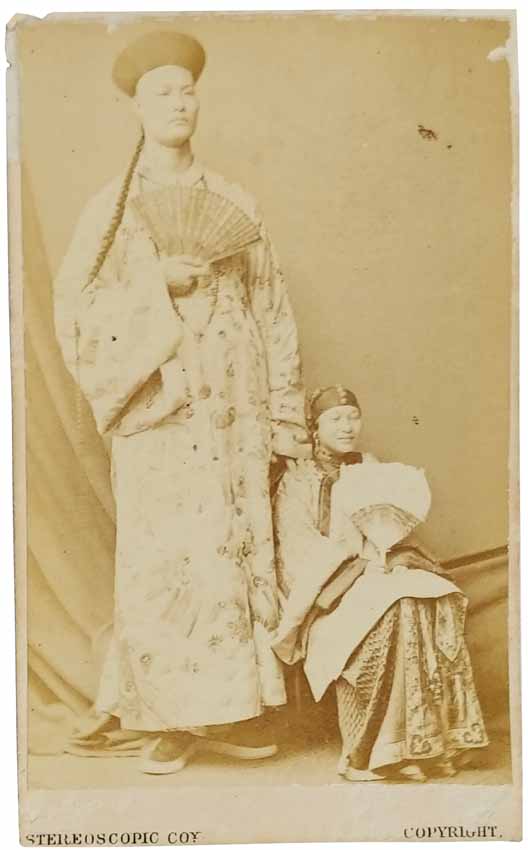
Chang-Yu-Sing – Famed Chinese Giant – Original Albumen CDV photograph
Chang-Yu-Sing Rare original CDV photograph of the Chang-Yu-Sing, also known as Chang Woo Gow (1841-1893), popularly dubbed "The Chinese Giant", together with his wife seated beside him. Chang grew to nearly 8 feet in height, married a beautiful "normal" named King Foo (her name literally means "the fair lily"). Photographed and published by The London Stereoscopic & Photographic Company whose studio was situated on Regent Street, between 1865 and 1867. Chang-Yu-Sing was a famous circus and sideshow performer, and was prolific in the business. He performed with Barnum, Bailey, and Hutchinson. Standing at 7 feet and 8.75 inches (235.5 cm) tall, in some performances, he appeared with "Chung Mow, The Chinese dwarf," making a most dramatic contrast and most engaging performance. Early biographical accounts state that he was born in the city of Fychow in Au-Hwy province [Huizhou in Anhui], in Eastern China, a region in the basins of the Yangtse and Huai rivers. He was a man of exceptional intelligence, speaking at least 10 languages. He was well-travelled, owing to the nature of his work. In 1865, he was persuaded to tour London, and headed the call, departing from Shanghai with Lady Chang, Chung Mow, his interpreter, two other Chinese individuals Alook and A'Yang, and an agent James Marquis Chisholm. In London he held levées at the Egyptian Hall and was invited to Malborough House to visit the Duke of Cambridge.For several years he toured England. He was an attraction at the Paris Exposition of 1867, visited Ireland, then Scotland where he celebrated New Year's Eve 1869 in Aberdeen. His agent at this time, since 1869 or earlier, was Edward Parlett.- $375
- $375

12 Masterpieces of Korean Arts with the Seal of the President of Korea.
Anon. A special copy, bearing the South Korean Presidential Seal, quite conceivably a unique one-off presentation copy from the Korean Government, of the photogravure portfolio, showcasing a select few of the exquisite Korean art works, which were jointly selected by a Korean-American committee and displayed at the National Gallery of Art in Washington, D.C. exhibition "Masterpieces of Korean Arts" held from 15 December 1957 to 12 January 1958. Folio. Complete, with 12 full colour photogravures, each bordered with loosely placed captioned leaf, and contained in its own folding cardstock covers bearing the portfolio title to front and a detailed historical and physical description to interior. Folders open from left to right, suggesting that this work was printed in Korea. Text is in both Korean and English. Publisher's original cloth teal and gold patterned portfolio covers, with two intact bone clasps for secure closure, and gilt presidential seal to front. Photogravure leafs measure approximately 42,5 x 34 cm. Portfolio measures approximately 43 x 34,5 x 3,5 cm Mild age-toning and wear to boards with one cosmetic tear to cloth to interior of one flap, otherwise in very good and original condition, a most unusual variant of this beautiful work, and most likely a Presentation copy from the South Korean Government. The present item is quite rare in any state, but especially this one as it shows a gilt phoenix and flower (Rose of Sharon) emblem found on the presidential seal of South Korea. It is most likely a Presentation Copy from the Korean Government to America, as a memorial to their collaboration of hosting a superb exhibition of historic Korean Art. OCLC shows a few 'standard' editions in libraries. The status and authority of the President of South Korea, officially the Republic of Korea, is represented by a symbolic phoenix emblem. The virtues represented by the mythological bird are parallel to the values a king had to pursue in governing the people, and the design of phoenix was attached on the ceiling of the throne hall of Gyeongbokgung palace, which was the main palace during much of the Joseon Kingdom (1392-1910). The design of the phoenix is still used today as the emblem that represents the office of the President of Korea. The exhibition "Masterpieces of Korean Art" was held at the National Gallery of Art in Washington, D.C., from 15 December 1957 to 12 January 1958. A joint committee of Koreans and Americans selected 187 objects, with the aim of presenting a cross section of Korean art from 200 B.C. to about 1900.- $375
- $375
![Honzo Zufu [Illustrated Manual of Medicinal Plants / Iconographia Plantarum]](https://rarebookinsider.com/wp-content/uploads/2023/07/31376698237.jpg)
Honzo Zufu [Illustrated Manual of Medicinal Plants / Iconographia Plantarum]
Iwasaki Tsunemasa (Kan-en) A most pleasing and highly illustrative Japanese monograph on mushrooms, being a copy of the work on medicinal mushrooms, from the multi-volume compendium of Iwasaki Tsunemasa titled Honzo Zufu. 8vo. 54 pages, offset colour-printed facsimile. Traditional karitoji paper binding string-stitched at spine, fukurotoji style ("bound-pocket" with folded leafs bound into spine), and opening from left to right. Ivory paper covers, title label, official red ink stamp to the first text leaf. All text is in Japanese. Volume measures approximately 17,5 x 26 cm. Very good condition, a visually striking historic work. Only six original sets of his work exist in Japan. The Royal Botanic Gardens, Kew, also possesses a complete set of the original manuscript volumes with hand-coloured woodblock print illustrations; else this monumental work is exceedingly scarce. Honzo Zufu or "Illustrated Manual of Medicinal Plants" is the work of Tsunemasa Iwasaki (1786-1842), a Japanese botanist, zoologist and entomologist who compiled and published the valuable compendium in 93 volumes between 1830 and 1844. Honzo Zufu comprises illustrations and descriptions of some 2,920 plants, chiefly of Japanese origin. A classic work of botanical classification, begun in woodcut, then continued in manuscript form during the mid-19th century, it was finally edited by Shirai and published in final form, printed by colour woodblock with descriptions of species in Japanese, and accompanied by a Japanese-Latin index, in 1920-22. In 1828 the first volumes of Honzo Zufu were printed, with uncolored woodcut prints. Beginning in 1829, he issued manuscript volumes of a vastly expanded work under the same title, beautifully illustrated by watercolour paintings. Tsunemasa Iwasaki continued to work diligently, printing and distributing new volumes at the rate of about four volumes per year until the work was finished. A complete set is said to have been presented and dedicated to the Shogun in 1844, signaling its completion on a most honourable manner. Iwasaki was better known as Kan-en, his sobriquet which translates literally to "irrigation of a garden for plants". He was a samurai in the service of the Tokugawa Shogunate, a born naturalist, and had access to about 150 illustrated volumes of Japanese botanical books. In 1826 at Edo, he had also become acquainted with the German physician and botanist Philipp Franz Balthasar von Siebold (1796-1866) who achieved prominence by his studies of Japanese flora and fauna and the introduction of Western medicine in Japan. He was the father of the first female Japanese doctor educated in Western medicine, Kusumoto Ine.- $750
- $750

Kamishibai Propaganda Play, Titled Uesugi Yozan, Containing Colour Illustration of Samurai Warriors Working in the Fields Aid in Food Production for the Nation at War.
Anon Kamishibai propaganda play / Japanese picture show (kamishibai) illustrating Samurai warriors plying away in the fields aid in food production for the nation at war. Folio. The complete work, comprising 20 offset full-colour printed illustrative cards which together form a story to educate or indoctrinate the viewer with nationalist concepts during the Second World War, each with printed story text to verso, one of the cards being the title and publishing information. Text is in Japanese. Contained in publisher's original paper portfolio covers, with title label to front. Story cards measure approximately 38 x 26 cm. Portfolio covers measure approximately 39 x 27 x 1 cm. Some age-toning and wear to portfolio, otherwise in very good and original condition, cards retaining vivid impression, a fascinating and scarce Second World War propaganda presentation. Japanese wartime propaganda was distributed through films, magazines and newspapers, radio, books, cartoons and the education system. Publications such as the present illustrative stories, promoted the ideal citizen's nationalistic point of view, indoctrinating civilians to work collectively and in support of their government's actions, even when creating some form of imposition on the citizen himself. Kamishibai are Japanese paper plays that gained popularity among children in the 1930s and were subsequently used as a medium for propaganda during World War II. Also referred to as a "Picture Card Show," they were made for influencing youth with their engaging storylines and vivid imagery. In 1940, elementary schools were renamed "Citizen's Schools." Textbooks became vivid, engaging, and contained militaristic picture-books. During the course of World War II, the Japanese government attempted to indoctrinate Japanese children through education and propaganda. Both methods nationalized youth and encouraged them to support the war effort. Science curriculum, for example education taught children about agriculture so they could better assist in food production for the nation. Youth were expected to volunteer in factories and farms to replace the conscripted labor force. Additionally, "kokutai," meaning the uniqueness of the Japanese people in having a leader with spiritual origins, was officially promulgated by the government, including a text book distributed by the Ministry of Education. The purpose of this instruction was to ensure that every child regarded himself first of all as a Japanese and was grateful for the "family polity" structure of government, with its apex in the emperor. Indeed, little effort was made during the course of the war to explain to the Japanese people what it was fought for; instead, it was presented as a chance to rally about the emperor. This is a story of Samurai warriors working in the fields with ordinary people in order to help grow food, a clever example using the elite class that all look up to, in order to encourage citizens to contribute to Japan's efforts in World War II. It is cleverly named after the famous and revered Uesugi Yozan, who at the young age of 17 became daimyo of the economically failing Yonezawa domain, and through hard work and sacrifice, led his people and feudal land back to prosperity. Uesugi Yozan (1751-1822), the daimyo (feudal baron) who restored the fortunes of the impoverished Yonezawa domain, is famously known as one of Japan's most virtuous lords. Perhaps the most famous words left by Yozan are, "To achieve, one must act. To not act is to not achieve; this is true in all things. The inability to achieve is the result of inaction." Indeed, Yozan is a fitting an influential figure to support this propaganda and motivate citizens to contribute their efforts to winning the war.- $1,750
- $1,750
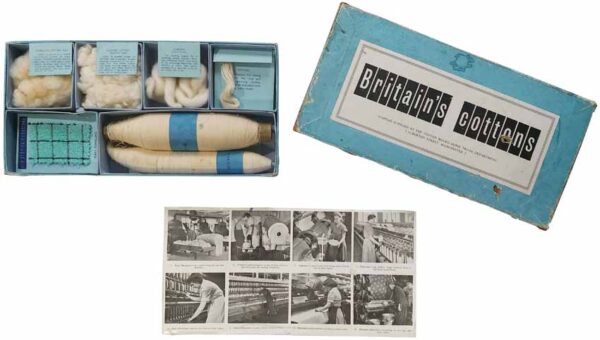
Britain’s Cottons: Vintage Sample Box by the Cotton Board Home Trade Department.
Anon. Boxed samples supplied by the Cotton Board Home Trade Department, containing cotton samples in seven formats at different stages of production, thirteen unique fabric swatches made from said cotton, each of the samples and swatches accompanied by a text description on a blue card. Together with the original photographic pictorial insert printed recto and verso to illustrate industrial cotton processing and provide statistics to entice commercial buyers. Original blue cardboard box measuring approximately 32 x 16 x 4 cm, with six box compartments within it serving to neatly separate and display the contents, and paper label to front. Wear and pierce marks to box, otherwise in excellent condition, its contents well preserved, an intact and complete item. Samples show cotton at various stages, including: An American Cotton Boll, Cleaned Cotton (Scutcher Lap), Carding (Card Silver), Slubbing, Roving, a Mule Cop of weft yarn ready for use in a loom shuttle, a Ring Tube of weft yarn suitable for warp in the weaving process, 13 finished woven fabric swatches, most of which are dyed. Statistics printed on the inserted leaf, reveal that in the year 1960, the United Kingdom exported cotton goods amounting to a value of £63,000,000 while local consumers purchased approximately 1,800 million square yards of cotton textiles. Further listing all the countries from where raw cotton and the like was imported, the United Kingdom purchased 822 million lbs. From this, the finished product of cotton textiles exported to Africa, Australia and New Zealand, America, and Western Europe, amounted to 327 million square yards exported. An astounding 222,720 workers were employed in the United Kingdom Cotton Industry, mostly in Lancashire, but also including the neighbouring districts of Yorkshire, Derbyshire and Cheshire. The Cotton Board was an organisation to oversee the organisation, research, marketing and promoting the cotton textile industry mainly based in Lancashire and Glasgow. A voluntary Cotton Board was set up in 1940 to "promote the welfare of the industry by internal reorganisation, by the development of export trade, scientific research, propaganda and other means." The board was given statutory status from 1948 to 1972 under the Industrial Organisation and Development Act 1947, and was known in its last years as the Textile Council. The Board had equal representation from industry and trades unions, with four members each, plus three independent members. It was given the power to levy up to £250,000 a year from the industry. Its headquarters was in Manchester, together with the "Colour, Design and Style Centre", which became the public face of the board. Between 1956 and 1962, the Cotton Board organised promotions to try and increase sales of Lancashire cotton within the UK, using generic marks, particularly the slogan "Buy British Cottons" - as seen on the leaf in the present display box. Its initiatives included new methods for utilising labour, recruitment and training, the encouragement of collaboration within the cotton industry, and design innovations. British fashion designs and fabrics were showcased at national and international exhibitions, ranging from an exhibition on the history of the cotton mills and a display of 1960s children's clothing to soft furnishing promotions at large stores and national fashion shows. Initiated by the Cotton Industry Act 1959, the Board engaged in a major attempt to reorganise the cotton industry, which entailed "the scrapping of machinery and compensation for redundant workers in the industry, which was carried through with great success and great expedition". Regrettably, a combination of reduced consumer demand, poor marketing and cheaper Commonwealth imports during the period of reorganisation created, a reduction of confidence in the industry, according to the Board's chairman Lord Rochdale. This both reduced the amount asked for by industry and invested by the government and resulted in mac- $175
- $175
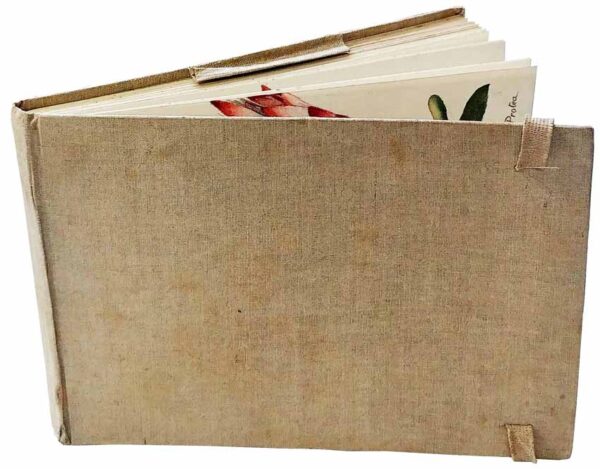
Album of Watercolour Albums: South Africa Botanicals.
Anon Album of watercolours devoted to flowering plants native to South Africa. Contains 30 images hand drawn and painted recto only one per leaf, most named in manuscript by the artist. A presentation copy inscribed to front pastedown, "E. Lawdon. From J. Bincker Dec. 1906". Oblong 8vo. sketch book made by Winsor & Newton whose label is affixed to front pastedown, with Whatman's drawing paper, taupe cloth boards, pencil sleeve (pencil not present), and a stretch band for secure closure. Volume measures approximately 19 x 13 cm. Minor age-toning to boards, small ink marks to verso, otherwise in very good condition, internally clean and bright, A pleasing work with lovely renderings of South African flora. Some of the flora painted in the present album include: Protea; Erica; Morea (commonly known as the Cape tulip); Aloe Davyama; Erythina Caffra (the African Coral tree); Ornithogalum; Gladiolous; Striilitzia; Vellozia retinerius; Striga elegans; Watsonia; Crassula; Hypoxis; Salvia africana; Gomphocarpus. The artist may be Johanna Jacoba Brincker (1842-1923, née KNAB) of Stellenbosch, South Africa. Johanna Jacoba Knab was born in South Africa, on 12 June 1842 in Stellenbosch. Little is known about Johanna, though she lived in South Africa and Southwest Africa [now Namibia] for her whole life, and she was a missionary to the Herero people, having a complete understanding of their language and customs. We get a fuller picture of her adult life through her husband, putting her in the circles of notable German Rhenish missionaries. On 10 February 1864 in Stellenbosch she married German missionary Peter Heinrich Brinckner, born 9 May 1836 in Isselhorst, Westfalen. Brinckner had arrived in South Africa in 1863. After completing his theological training, Brincker was ordained in November 1862 and seconded to German South West Africa on 5 November 1862, with the task of proselytizing the Herero and Nama, who were at odds with one another. After an 83-day journey, he landed in Cape Town at the beginning of February 1863. In Stellenbosch, about 50 kilometers east of Cape Town, he was welcomed by missionary brothers. There he met his future wife Johanna Rath and became engaged to her. Missionary Johann Rath, who had worked with the Herero for 15 years, introduced Brincker to the Herero language. By early 1864 Peter had returned to Stellenbosch, where he married Johanna. Together, on 20 February 1864, they took over the work in the mission station of Otjikango, called Klein-Barmen, which had been founded twenty years earlier. Because of fighting between Herero and Nama, the couple had to flee to Otjimbingwe seven times over the next year and a half. In September 1865 the station in Otjikango was destroyed by the Nama and had to be painstakingly rebuilt.- $975
- $975
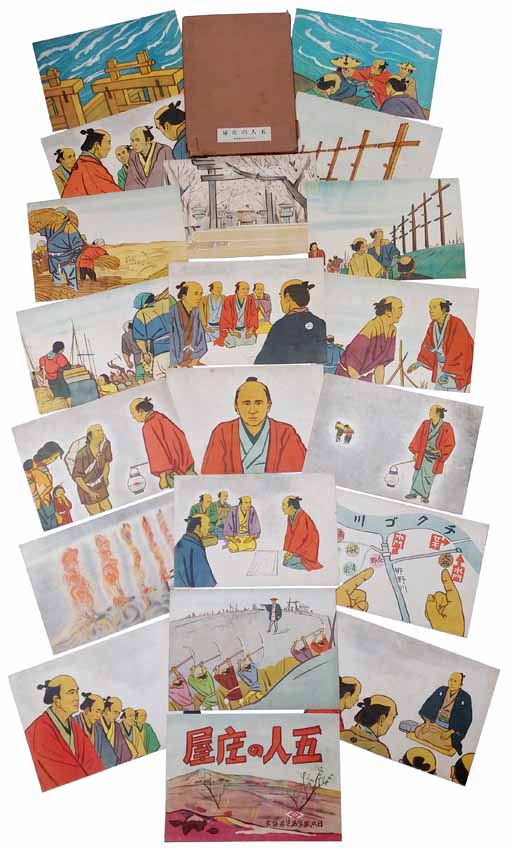
Kamishibai Propaganda Play, Titled Gonin no Shoya, Containing Colour Illustrations to Depict Five Innovative Heroic Headmen.
Anon Creator: Hiroshi Hirabayashi. Kamishibai propaganda play / Japanese picture show (kamishibai) illustrating the benefits and immense moral obligation of collaborating with one other for survival. Folio. The complete work, comprising 20 offset full-colour printed illustrative cards which together form a story to educate or indoctrinate the viewer with nationalist concepts during the Second World War, each with printed story text to verso, one of the cards being the title and publishing information. Text is in Japanese. Contained in publisher's original paper portfolio covers, with title label to front. Story cards measure approximately 38 x 26 cm. Portfolio covers measure approximately 39 x 27 x 1 cm. Some age-toning and wear to portfolio, otherwise in very good and original condition, cards retaining vivid impression, a fascinating and scarce Second World War propaganda presentation. Japanese wartime propaganda was distributed through films, magazines and newspapers, radio, books, cartoons and the education system. Publications such as the present illustrative stories, promoted the ideal citizen's nationalistic point of view, indoctrinating civilians to work collectively and in support of their government's actions, even when creating some form of imposition on the citizen himself. Kamishibai are Japanese paper plays that gained popularity among children in the 1930s and were subsequently used as a medium for propaganda during World War II. Also referred to as a "Picture Card Show," they were made for influencing youth with their engaging storylines and vivid imagery. In 1940, elementary schools were renamed "Citizen's Schools." Textbooks became vivid, engaging, and contained militaristic picture-books. During the course of World War II, the Japanese government attempted to indoctrinate Japanese children through education and propaganda. Both methods nationalized youth and encouraged them to support the war effort. Science curriculum, for example education taught children about agriculture so they could better assist in food production for the nation. Youth were expected to volunteer in factories and farms to replace the conscripted labor force. Additionally, "kokutai," meaning the uniqueness of the Japanese people in having a leader with spiritual origins, was officially promulgated by the government, including a text book distributed by the Ministry of Education. The purpose of this instruction was to ensure that every child regarded himself first of all as a Japanese and was grateful for the "family polity" structure of government, with its apex in the emperor. Indeed, little effort was made during the course of the war to explain to the Japanese people what it was fought for; instead, it was presented as a chance to rally about the emperor. This is a dramatic story of collaboration and innovation, its ultimate message being that these virtues are necessary for survival of a society and the individual. Sustenance being the key to survival, the story unfolds as follows. A village in Western Japan suffering a long arid season which led to drought, was unable to support vegetation and was seeing abandonment as many farmers left the region. Evidently this was a large village, having five shoya (village headman), and the latter devised an irrigation plan to restore its agriculture and ultimately preserve the village. In order to instill the urgency of success with the undertaking, the local bugyo (governor) approved the project under the alarming condition that if the project failed, the five headmen who also owned estates in the region, would be burnt alive at the stake. He had five hanging platforms erected in preparation of failure, and also to motivate them to accomplish the task lest they meet a gruesome public fate. Villagers supported the idea and all hands worked diligently to ensure its success. Indeed, working together with a common goal was the key. The water flowed abundantly. The village was saved, and so were the li- $1,750
- $1,750

Kamishibai Propaganda Play, Titled Ninomiya Kinjiro, Containing Colour Illustration Intended to Portray the Importance of Taxation, Specifically Relating to the All-Important Commodity, Rice.
Anon Kamishibai propaganda plays / Japanese picture show (kamishibai) illustrating the importance of taxation, specifically relating to the all-important commodity: rice. Folio. The complete work, comprising 20 offset full-colour printed illustrative cards which together form a story to educate or indoctrinate the viewer with nationalist concepts during the Second World War, each with printed story text to verso, one of the cards being the title and publishing information. Text is in Japanese. Contained in publisher's original paper portfolio covers, with title label to front. Story cards measure approximately 38 x 26 cm. Portfolio covers measure approximately 39 x 27 x 1 cm. Some age-toning and wear to portfolio, otherwise in very good and original condition, cards retaining vivid impression, a fascinating Second World War propaganda presentation. Japanese wartime propaganda was distributed through films, magazines and newspapers, radio, books, cartoons and the education system. Publications such as the present illustrative stories, promoted the ideal citizen's nationalistic point of view, indoctrinating civilians to work collectively and in support of their government's actions, even when creating some form of imposition on the citizen himself. Kamishibai are Japanese paper plays that gained popularity among children in the 1930s and were subsequently used as a medium for propaganda during World War II. Also referred to as a "Picture Card Show," they were made for influencing youth with their engaging storylines and vivid imagery. In 1940, elementary schools were renamed "Citizen's Schools." Textbooks became vivid, engaging, and contained militaristic picture-books. During the course of World War II, the Japanese government attempted to indoctrinate Japanese children through education and propaganda. Both methods nationalized youth and encouraged them to support the war effort. Science curriculum, for example education taught children about agriculture so they could better assist in food production for the nation. Youth were expected to volunteer in factories and farms to replace the conscripted labor force. Additionally, "kokutai," meaning the uniqueness of the Japanese people in having a leader with spiritual origins, was officially promulgated by the government, including a text book distributed by the Ministry of Education. The purpose of this instruction was to ensure that every child regarded himself first of all as a Japanese and was grateful for the "family polity" structure of government, with its apex in the emperor. Indeed, little effort was made during the course of the war to explain to the Japanese people what it was fought for; instead, it was presented as a chance to rally about the emperor. By using the example of the esteemed agrarian reformer and economic savant Ninomiya Kinjiro who was born into peasantry, lost his family and home in a disaster, and overcame all odds to become a notable leader and economic reformer, this story promotes the importance of government taxation, even on basic needs such as rice. Ninomiya Kinjiro (1787-1856) was an important agrarian reformer and economic thinker of the late Edo period. His legendary diligence and studiousness as a child made him a natural exemplar for Japanese schoolchildren. At one time, most every elementary school in Japan displayed a statue depicting Ninomiya as a youth with a bundle of firewood on his back and an open book in his hand.- $1,750
- $1,750

Poster Calendar from a Chinese Artist Promoting the Qidong Tobacco Company.
Ni Gengye Poster calendar titled "Girl at Airfield" and designed by artist Ni Gengye, for the Qidong Tobacco Company, to promote happiness in connection with their smoking products. From the collection of Agnes Tabah. Calendar measures approximately 103 x 38 cm. Ni Gengye is a Chinese artist whose work is highly sought after, and which fetches a premium when available on any market. He produced a notable number of works, many of them being calendar posters. He created advertisements for other tobacco companies including Hatamen Tobacco and the British American Tobacco (BAT). His date and place of birth are unknown, though some estimate his life span to be from approximately 1900-1965. Calendar posters were a particular genre of commercial imagery of the period. Typically, they were produced by tobacco, textile, soap, or perfume companies and were distributed across a wide geographical range. Almost invariably, they depict female figures in various guises, which were a key part of their appeal. Formally, the female figures are generally portrayed in an illusionistic manner, though chiaroscuro or shading is generally subdued. There is usually a frame, outside of which an image of the product and other necessary information are displayed. This 'calendar-poster' style had strong connotations of commercialism and was consciously avoided by designers of literary book and magazine covers. This stylistic differentiation probably served to mark literary works as a different type of commercial product. The format of the present poster-calendar was designed by Zhang Guangyu around 1931. It was mostly frequently tall and narrow, into which he introduced a large plaque for the calendar in the lower third of the space. This plaque itself was framed with ornamental designs and contrasted against a richly decorated background of various motifs. The tobacco vendor's cigarette packages were arranged on each side of, and sometimes below, the central plaque. This formula was frequently utilized, and spin-offs continued at BAT throughout the 1930s. It is thought that Ni Gengye's "Woman at an Airfield" is among the last uses of Zhang's formatting design. It is dated 1938 according to the reign characters Kangde, indicating that the poster was probably destined for advertisement in Manchuria, where the Japanese had set up the puppet state of Manchuko. The woman waves as if greeting an unseen person, having alighted from the airplane in the background, as she moves across the field toward the terminal. An alternate interpretation is also possible: the young woman might be departing, making her way across the tarmac, but turns to wave farewell to a friend, just prior to boarding the aircraft. If this is the case, Ni's picture is an ironic, unwitting, and poignant farewell to the era of advertisement calendars, for by 1938, the Japanese, entrenched in Shanghai, succeeded in pretty much cutting it off from the trade world and from the rest of China.- $375
- $375
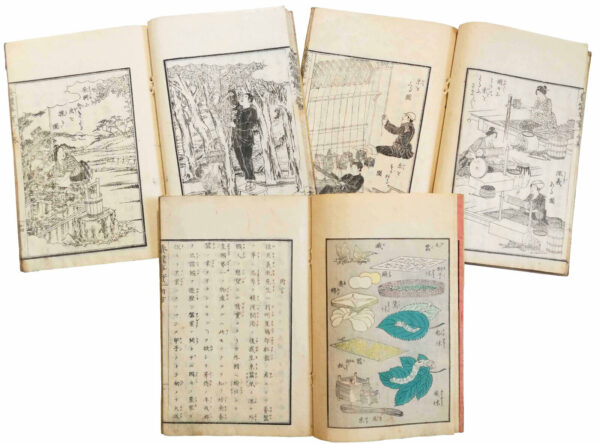
San Jijitsu. Japanese Coloured Woodblock Prints on Sericulture (Making of Silk).
Sakai Yoshitane A rare nineteenth century Japanese tutorial on sericulture (the making of silk), including details on the silk worms from which the fine thread is harvested, produced in woodblock print. 8vo. 3 volumes, 209 pages combined, with publisher's details to red frontis leaf. The complete text, including 31 full page wood printed illustrations - the first three being beautifully hand coloured. Traditional karitoji binding ("semi-bound" meaning title page and contents without a book cover) string-stitched at spine, fukurotoji style ("bound-pocket" with folded leafs bound into spine), and opening from left to right. Yellow paper covers, titled in manuscript ink to verso. Each volume with a red ink stamp to the first text leaf. All text is in Japanese. Each volume measures approximately 15 x 22 cm. Housed together in purpose-made three-panel folding portfolio, blue cloth boards with working bone clasps, measuring approximately 16,5 x 23 x 3,5 cm. Ink blemishes to two of the illustrations, quite likely a printing mishap, minor age-toning primarily to boards, otherwise very good and original condition, a pleasing historic work dealing with silk production in Japan. Beginning with three lovely hand-coloured woodcut illustrations, the first volume describes the coveted miniscule Bombyx mori that creates the delicate strands that are used to produce the world's finest fabric. It goes on to explain the process, how to lay the eggs on a sheet of paper, the importance of harvesting mulberry leaves to feed the larvae, transferring grown silkworms to other bamboo mats to feed them, and the multiple tools needed for the job at hand. Fieldwork is the focus of the second and largest volume, which demonstrates the arduous task of planting and maintaining a mulberry plantation, which will ultimately determine the health of the silkworms and one's profitability. In the third volume, we see men gathering twigs and women loosely weaving these into safe-havens for the silkworms to settle comfortable. The cocoons are placed on round trays, and eventually the silkworm moth fly away after hatching. Various stages of preparing the thread are shown, for example stretching the silk floss hand-spinning the thread from cocoons sitting in a pan of boiling water. A merchandising scene concludes the illustrations.- $1,250
- $1,250
![Banpaku Shimoda nyuko kikigaki. [Oral Accounts on Foreign Ships which Entered Shimoda Port.]](https://rarebookinsider.com/wp-content/uploads/2023/07/31351517008-600x511.jpg)
Banpaku Shimoda nyuko kikigaki. [Oral Accounts on Foreign Ships which Entered Shimoda Port.]
Anon. Invaluable manuscript chronology of the earliest ships entering the port of Shimoda after the implementation of the Japanese-American treaty which opened up foreign trade with the previously isolationist nation, covering two years from February 1854 to February 1856, presented in the meticulous hand of a contemporary observer who compiled firsthand information as well as his own, together with a manuscript drawing of a Dutch sea captain in naval attire, made by Kitajima Toen. Manuscript: 8vo. 30 pages plus titled cover, string-tied at center of spine with rolled up paper, opening from left to right, measuring approximately 17 x 24 cm. Text is in Japanese, with occasional annotations in red ink. Drawing: Single leaf measuring approximately 24 x 33 cm, titled and signed in manuscript, with red ink stamp. Some creasing and indication of burrowing, otherwise in very good and original condition, clean and bright internally, an invaluable log of the earliest trade activity from the onset of the Convention of Kanagawa. With precise details, the writer keeps a record of vessels from America, Russia and France, arriving at Edo Bay, beginning with the return of Commodore Perry in February 1854 for the signing of what would be the Kanagawa Treaty, and continuing for two full years, featuring descriptions of the ships including dimensions and armament, repairs and supplies procured, captains' names and crew sizes, and their activities in Shimoda. This document is not only an invaluable historical log of the first and most significant foreign vessels to interact with Japan during the formative years of the Unequal Treaties, it may have been used in the Japanese study of foreign ships for their own benefit. Immediately after bowing to the demands of the powerful Western ships and their commanders, an active assimilation of Western technological advances in warships ensued in the Japanese Navy. In 1855 Japan acquired its first steam driven warship, and in 1857 its first screw driven warship. Japanese Naval students were sent abroad to naval schools in England, France, the Netherlands, and the like. By the end of the Tokugawa Shogunate in 1867, its navy would possess eight western-style steam warships. The first vessels mentioned in the manuscript are from Perry's daunting and expanded 'Black Ships' fleet, including the Mississippi which had been one of the original four, as well the Vandalia, the Southampton, the Powhatan, and the Supply, the latter of which joined the squadron after the actual landing on 8 March. The Russian vessels being described in 1854, include the Russian Imperial Navy flagship frigate 'Diana' commanded by Vice-Admiral Euphimy Vasil'evich Putiatin, and possibly his former flagship frigate 'Pallada' which had been performing survey missions around the Japanese coast since 1853 and whose crew was transferred to Diana upon her arrival. The crew members of the Diana are listed by name, including her Imperial Navy officers, a cook, a waiter, and an interpreter. The earliest French vessel to arrive after Commodore Perry's successful treaty implementation, was a cruiser that arrived in Shimoda in February 1855, being 'Le Lion' which also landed at the Ryukyu Islands with the French missionaries from the 'Missions Étrangères de Paris', Girard, Furet and Mermet, hoping to discuss their interests in evangilizing. Catholicism was strictly forbidden in Japan. They also landed at Naha, the main port of Okinawa, on 26 February. The cruiser was denied any official communication as a formal agreement did not exist between France and Japan. On this voyage, Father Louis Théodore Furet, an apostolic missionary, carried out instrumental observations at Nafa [Naha, Okinawa] on the Ryûkyû Islands. A set of the meteorological manuscripts by Father Furet was given to Jean Barthe, the physician onboard the French frigate 'La Sibylle', who forwarded them to the 'Académie des Sciences' in Paris and to the 'Société Météorologique de France'. Mete- $1,750
- $1,750
![Zokui Yosan Shinron. [Additional New Theories on Sericulture]](https://rarebookinsider.com/wp-content/uploads/2023/07/31351517007-600x515.jpg)
Zokui Yosan Shinron. [Additional New Theories on Sericulture]
Anon Historically significant and exceedingly scarce nineteenth century Japanese treatise on sericulture (the making of silk), by the man who remembered as "the father of modern sericulture and silkworm rearing methods", describing and illustrating his then revolutionary methods for better nurturing of the silk worms from which the fine thread is harvested, and ultimately producing higher quality silk, the inventions having become the standard for the industry and still employed today, produced in woodblock print. 8vo. 3 volumes, 278 pages combined, plus publisher's details to yellow frontis leaf in first volume. The complete text, illustrated with 10 pages of wood printed illustrations, two of which are fully hand coloured, and two being partially hand coloured. Traditional karitoji binding ("semi-bound" meaning title page and contents without a book cover) string-stitched at spine, fukurotoji style ("bound-pocket" with folded leafs bound into spine), and opening from left to right. Black paper covers, with title label to front, the first volume with a red ink stamp to publisher's detail leaf. All text is in Japanese. Together the volumes measure approximately 14,5 x 22 x 3 cm. Minor wear to boards, otherwise very good and original condition, internally bright, a pleasing historic work dealing with silk production in Japan. Tajima Yahei (1822-1898) was an influential silk farmer in the early Meiji period, whose legacy is that of a tremendously prosperous impact on the sericulture industry of Japan, with his development of a ventilation theory and method which proved to be highly successful and subsequently laid the foundations for modern sericultural production, and the most efficient design of a sericulture space. He had a small laboratory where he researched silkworm hybridization and silkworm diseases with the aid of a microscope, which was unusual in Japan at the time. Yahei's experiments in creating an ideal sericulture space led to his invention of a new sericulture theory and technique, the seiryo-iku. He concluded that sericulture is best carried out in a space with efficient cross ventilation, which includes a roof system and openings on four walls. He perfected these procedures at his own home, the farmhouse known as 'omoya' built in 1863, referred to today as the Tajima Yahei Sericulture Farm (Tajima Yahei kyu-taku), which is located in the Sakaishima neighborhood of the city of Isesaki, in the southern part of Gunma Prefecture. Silkworm growers travelled from far and wide to observe and learn the techniques and processes developed and implemented on this revolutionary farm. Yahei was also involved in exporting silkworm eggs and earned large profits from it. Yahei's techniques later became a foundation for the secchu-iku theorized by Takayama Chogoro, founder of Takayama-sha Sericulture School, which acted as a training centre and formal education institution for sericulture. Yahei also became one of the leading figures who developed the village of Shimamura through his achievement in sericulture. Born in 1822 as Tajima Kuniyasu and Yahei (the second), throughout his childhood, he travelled to advanced sericulture areas with his father in order to gain skills and experience in silkworm breeding, production and sales. Yahei's silkworm farm is one of the earliest examples of architecture specifically designed to improve sericulture.- $1,750
- $1,750
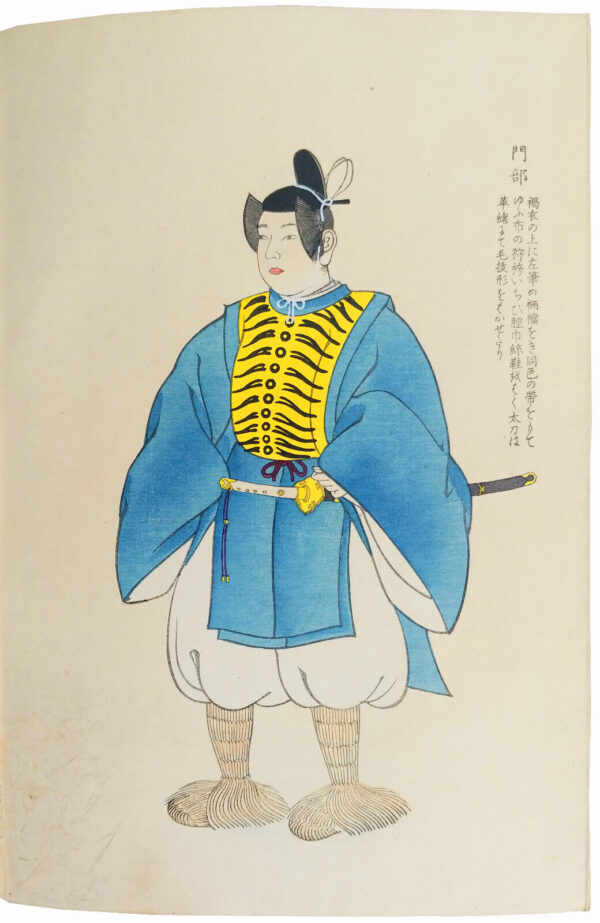
Reifuku Chakuyo Zu.
Imaizumi Sadasuke An outstanding illustrative work to record the details of the ceremonial dress worn in the Japanese Court, produced by Imaizumi Sadasuke, a scholar of the Kokugaku movement which emphasized Japanese classical studies who evidently researched the works of the eighteenth century noble Heizo Sadatake Ise. Woodblock print. The complete work. 8vo. 1 volume, opening from left to right, 16 pages, with 14 woodcut images, all of which are beautifully hand-painted in full colour and captioned in margins. Text is in Japanese. Title noted in manuscript to bottom fore-edge. In publisher's original yellow striped paper boards, with title slip to front. Traditional karitoji binding ("semi-bound" meaning title page and contents without a book cover) string-stitched at spine, fukurotoji style ("bound-pocket" with folded leafs bound into spine), and opening from left to right. Volume measures approximately 18 x 26 x 0,5 cm. Indication of additional small label removed from covers, otherwise in very good and original condition, a stellar work with vivid, meticulously coloured, woodcut illustration, internally crisp and clean. The official dress worn by court officials of early Imperial Japan, painted with meticulous detail to bring depth and vibrant colour. Court dress was unique to those possessing court ranks and those holding official positions. Fascinating accoutrements shown in the present volume include straw boots (waragutsu), ogi (folding fan), the kanmuri (tall black-lacquered silk gauze hat) worn by Shinto clergy, aristocrats and courtiers, remarkable gilded headdresses, high officers' kimonos made of the highest quality, exquisitely decorated fabric and military arms including the katana (curved sword), the tachi (traditional sword). The Bukan sokutai (ketteki no sokutai) sugata is the formal court wear (sokutai) of the military official (which is the meaning of 'bukan'). It was worn only by military officials of the fourth court rank and below. Men of the first through third rank wore the bunkan sokutai even if they held military appointments. The principal garment is the ketteki no ho. It featured, first, the kanmuri has a ken'ei (a wrapped tail) and oikake (lacquered horsehair "blinders" that sit on the cords of the kanmuri). The shoes are lacquered leather kanokutsu (a riding boot). Being a military outfit, a sword (hosotachi) is worn off the hirao, while a bow (yumi) is held in the hands. The quiver, either a hira yanagui (square quiver) or tsubo yanagui (a round quiver), holds arrows with two large hawk feather fletchings. For a hira yanagui, one has 15 or 22 arrows, depending on the school (Takakura Ryu or Yamashina Ryu), though only 7 arrows for a more restrictive tsubo yanagui. Although the hanpi may sometimes be dispensed with when wearing bunkan sokutai, it can never be left off when wearing bukan sokutai, since it can always be seen through the open sides. The Kachie sugata is the uniform of the imperial guards when on duty. The outfit is so named due to the kachie being the principal garment. It may look, superficially, like the bukan sokutai, but there are crucial differences. Although the kanmuri sports oikake, the tail is a thin one called a hosoei. Furthermore, the shitagasane and accompanying kyo, as well as the akomé are left off. Rather than the formal uenohakama, this outfit uses the more practical onohakama. The shoes are either cloth/hemp shoes, such as the makai, or straw shoes or boots (waragutsu). The sword worn is often a kenukigata tachi, or else a tachi in black mounts, and they are also likely to have a bow, quiver, and arrows.- $975
- $975
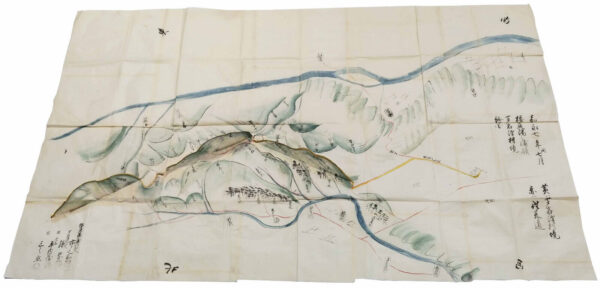
Manuscript Watercolour Map Illustrating the Village of Ashinazawa Tamayamababa and Its Environs, Depicting Japanese Samurai Horse Breeding Grounds
Anon. Large manuscript watercoloured map to illustrate the village of Ashinazawa Tamayamababa and its environs (in present-day Morioka, Iwate Prefecture), showing lands used by samurai of the ruling Nanbu Clan for raising and breeding horses, also highlighting three mountains in relief by way of tipped-in folding cutouts. Place names and text is in Japanese. Signed in manuscript by a Samurai named Sakura Baba, as well as three other notable officials. Map measures approximately 135 x 82 cm. Some creasing, otherwise in very good condition, a very unique manuscript painted map from the feudal Morioka Domain. The village shown is Ashinazawa Tamayamababa, situated within 30 km from Morioka, which was then the Morioka Domain (Morioka-han), a tozama feudal domain of Edo period, under the rule of the Nanbu Clan (Nanbu-shi) of samurai whose territory spanned most of northeastern Honshu in the Tohoku region. [Today, Morioka (Morioka-shi) is the capital city of Iwate Prefecture located in the Tohoku region of northern Japan. Ashinazawa is considered part of the Morioka district.] Ashinazawa Tamayamababa is also near, only 90 km, from Kakunodate (in present-day Akita Prefecture), also a former castle town and samurai stronghold. While Kakunodate Castle no longer remains, the town is famous for its samurai tradition and its hundreds of weeping cherry trees (shidarezakura). Apart from the loss of its castle, Kakunodate remains remarkably unchanged since its founding in 1620. The town was built with two distinct areas, the samurai district and the merchant district. Once home to 80 families, the samurai district still has some of the best examples of samurai architecture in all of Japan. Among the hills and near the village, some rather expansive horse-breeding fields are drawn on the map, presumably belonging to or at least managed by the Nanbu-shi samurai who signed the document. The horses would have been used by samurai warriors for military equestrianism, including bajutsu (a distinct form of martial art), for yabusame (mounted archery), and other practices of skilled battle on horse-back. Three mountains illustrated two-dimentionally, are all stratovolcanos forming part of the Ou Mountain range in the Tohoku region of northern Honshu. They appear to be illustrating Mount Iwate - the active volcano situated only 22 km from Ashinazawa, Mount Hachimantai - the highest peak in the Ou Mountains and only 46 km from Ashinazawa, and the active stratovolcano Akita-Komagatake located some 70 km from Ashinazawa. In red paint, several roadways are delineated, one of them reaching and following the summit line of one of the mountains. At the head of one of these roads, is a drawing of a cherry blossom trees, and an inscription which likely reads 'sakura', the term for of a group of cherry blossom trees, collectively. The flow of the Kakkonda and Shizukuishi rivers into the Kitakami is traced from the hills. In the distance, on the opposite side of the mountain ranges, a larger river is drawn, depicting the wider Tama River, which would eventually lead to Lake Tazawa. The Akita-Komagatake region is exceptionally lush, with several hundred species of alpine flora and would surely be an excellent place for horses to graze. Mount Hachimantai is especially characterized with hot springs, possibly being used as a source of warm water for cleaning or healing. In general, the vast region would be superb as a horse breeding ground. Horsemanship was an important duty and respected skill of the samurai. There were two classes of Samurai, and only upper-class samurai were allowed horses, although the lower class samurai who could find a way to possess their own horse, did so, with the belief that every samurai should have the honour and the benefit. Being on horse-back aided in part to best perform archery, spearmanship, and swordsmanship in battle. Horse-mounted samurai often fought by charging their horses at their opponent, in some cases causing a collision that- $2,750
- $2,750
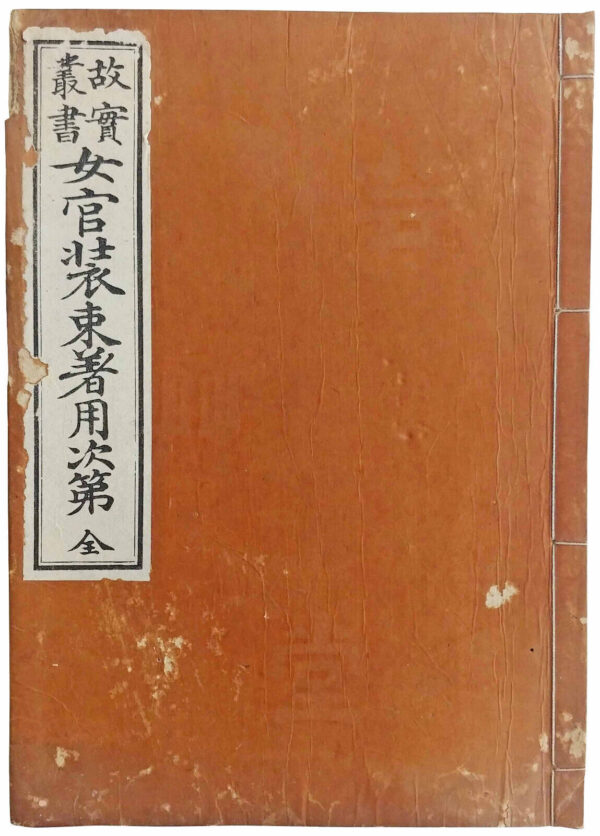
okan Syozoku Cyakuyo Sidai. Colour Illustrations of Japanese Noble Women’s Attires.
Imaizumi Sadasuke An outstanding work to illustrate the correct way for Japanese noblewomen to wear formal attire in the Japanese Court - the Nyokan's jyunihitoe, written by Imaizumi Sadasuke, a scholar of the Kokugaku movement which emphasized Japanese classical studies who evidently researched the works of the eighteenth century noble Heizo Sadatake Ise. Woodblock print. The complete work. 8vo. 1 volume, opening from left to right, 15 pages, with 14 woodcut images, all of which are beautifully hand-painted in full colour and captioned in margins. Text is in Japanese. In publisher's original brown paper boards, with title slip to front. Traditional karitoji binding ("semi-bound" meaning title page and contents without a book cover) string-stitched at spine, fukurotoji style ("bound-pocket" with folded leafs bound into spine), and opening from left to right. Volume measures approximately 18 x 25 x 0,5 cm. Chips and indication of burrowing to covers, otherwise in very good and original condition, a stellar work with vivid, meticulously coloured, woodcut illustration, internally crisp and clean. Striking woodcut illustrations of jyunihitoe - the official dress worn by female court officials and ladies-in-waiting of Imperial Japan, for approximately 1000 years from the Heian period to the Edo period, painted with meticulous detail to bring depth and vibrant colour. During the Heian period (794-1185) women could hold court offices of substantial responsibility, managing the affairs of the Emperor. Female palace attendants were employed by the Imperial Bureau of Palace Attendants from among the court aristocracy, but were required to have sufficient education in Chinese classics to be accepted. Women who held official positions and served in the Court of Japan from the Heian to the Edo period were called Nyokan (Nyobo, Kyujyo). The most famous is Murasaki Shikibu, who is considered the author of Tale of Genji. The imperial court offices were reserved for members of the court aristocracy and the ladies-in-waiting or 'palace attendants' were commonly educated members of the nobility. Female palace attendants were divided in two classes, which in turn had several ranks, signifying their task. The first class consisted of the nyokan, or ladies-in-waiting who held court offices: naishi-kami (shoji) naishi-suke (tenji) and naishi-no-jo (shoji). The second class were the female palace attendants: myobu, osashi, osue and nyoju. The ladies-in-waiting worked as personal assistants, tending to the Emperor's wardrobe, assisting the emperor's baths, serving meals, performing and attending court rituals. Ladies-in-waiting could be appointed as concubines, consorts or even Empresses by the Emperor or the heir to the throne. The function of a lady-in-waiting as potential concubine was abolished in 1924.- $975
- $975
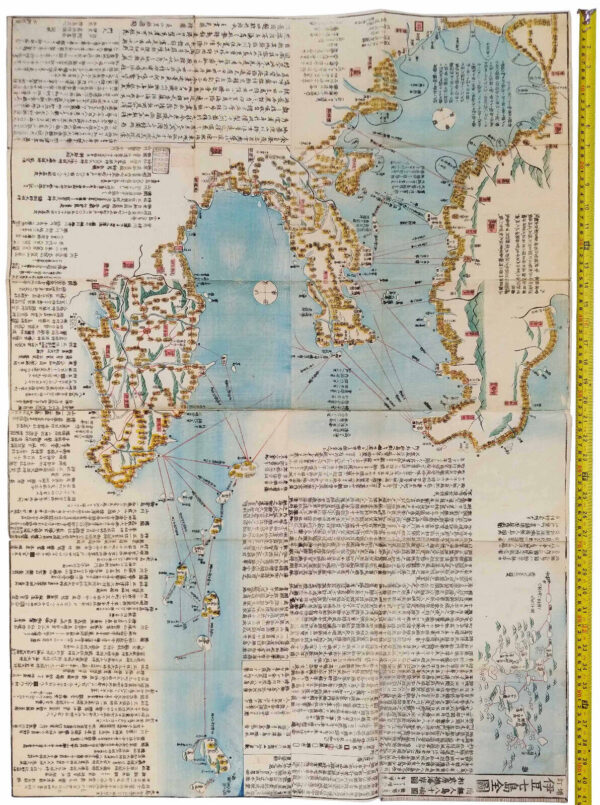
Large Woodcut Watercoloured Map Illustrating the Remote and Mostly Uninhabited Nanpo and Ogasawara Archipelagos
Tojo Kindai, Abe Rekisai, et al. English translation of map title: [The Complete Map of the Seven Islands of Izu with a Map of the Eighty Uninhabited Islands.] Large woodcut watercoloured map titled to illustrate the remote and mostly uninhabited Nanpo and Ogasawara archipelagos, lying some 1000 kilometers south of Tokyo, of the important and banned map produce jointly by scholar and official Tojo Kindai and Abe Rekisai, from a limited run of 500 maps printed in 1848, for private distribution, not for sale to the public owing to the Tempo reform which oppressed any interest in subject matters concerning Western interests (Hawaiians and westerners were inhabiting the island). Kindai was imprisoned and subsequently exiled from Edo for the publication of the map; Rekisai was a promoter of Japanese settlement of the Bonin islands and it appears that he may have been spared from persecution. Folded and mounted to two striped cardstock boards at two ends for neat storage, also giving it the appearance of a typical Japanese book for concealing the content. Title, legend, placenames, and detailed descriptions, are all in Japanese. Map measures approximately 105 x 76 cm, folding into sleeve for safe storage at approximately 25 x 18 cm. Some age-toning, title label to boards worn, reinforced to one fold, otherwise in very good condition, beautifully preserved, with lovely colour accents, extensive detail, and retianing a strong impression. A rare surviving woodcut map that was banned by the shogunate. Tojo Kindai (1795-1878) was a Confucian scholar, calligrapher and cartographer active in Edo, where he was born, during the mid-nineteenth century. He studied under Ota Kinjo and Kameda Pengsai, and later served the Fukushima Daimyo. His aim with the production of this map was to illustrate the strategic importance of the Bonin islands, but by doing so, revealed secret information, essentially information about Western civilians and their successful agragarian activites on the islands. Knowledge of western ways was strictly prohibited. He was gaoled for seven months, then exiled from Edo for eight years after producing the map, which centered on the coveted southern islands that would become Japan's first overseas colony only fourteen years later (still during his lifetime). Ironically, criminals in Edo were often confined on Hachijojima island (in which he clearly took interest) or Miyakejima of the nearby Izu island group, especially political prisoners such as Kindai would have been labeled. Abe Rekisai (1805-1870), also known as Abe Yoshito, Abe Tomonoshin, and Hashukuen, born in the Toshima District of Edo, was a Japanese botanist, herbalist and author who published many works, with subjects on horticulture, botany, and even social conflict resolution. In 1856 he published geographic descriptions of Hokkaido where Abe Sho nin, his ancestor, twice visited to collect medicinal plants, commissioned by the Shogunate government (Bakufu). A most fascinating map produced twenty years before Japan's Tokugawa (Edo) shogunate had claimed the Nanpo and Ogasawara archipelagos lying some 1000 kilometers south of Tokyo in 1862, the islands are named, and communication routes between them are clearly indicated. Mountain ranges are also shown, both on and around the islands. It was the height of the Tempo reform of 1841-1843 when Kindai first published the map, a highly risky endeavour with the economic and political reform that dealt a sweeping blow to the publishing industry. Resolute and unflappable, Kindai continued to seek out more information on the subject, and again printed a small number of his map, slightly revised, in 1848. It too, was banned by the shogunate, who undoubtedly gathered and destroyed all copies they could find, a common practice of the day, which yet again inspired and necessitated scholars to become clandestine transcribers of important works. For his map, now produced twice and deemed "an act of political agitation," Kindai found himself in violation of s- $2,750
- $2,750
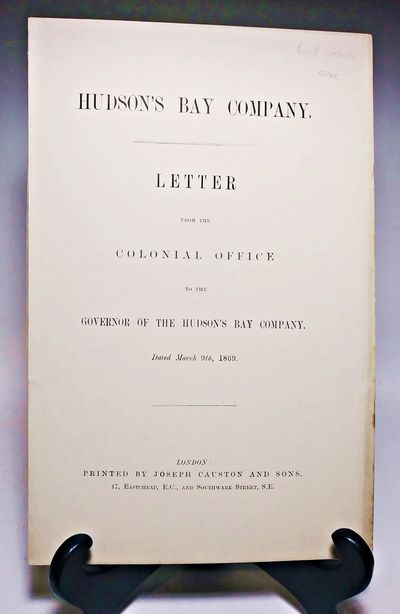
HUDSON'S BAY COMPANY, LETTER FROM THE COLONIAL OFFICE to the Governor of the Hudson's Bay Company, dated March 9, 1869
Hudson's Bay Company]- Great Britain (Colonial Office) London, 1869 London: Printed by Joseph Causton & Sons, [1869], 1869. Pp.9, Pamphlet-stitched binding. Self Wrappers, with cover title. Rare. "Earl Granville has had under review the correspondence which has passed respecting the proposed transfer to Canada of the jurisdiction and territorial rights of the Hudson's Bay Company in North America... It is not creditable to this Country, that any inhabited parts of Her Majesty's dominions should be without a recognized government capable of enforcing the law, and responsible to neighbouring countries for the performance of international obligations... The terms which his Lordship now proposes, are as follows: [terms no.'d I to XII follow] Signed, Frederic Rogers." -from the text. Slight tanning to the fore-edge margin, else fine copy. Peel 502. Sir Stafford Northcote was governor of HBC, 1869-1875. . First Thus. Soft Cover. Fine. Octavo. Pamphlet.- $391
- $391
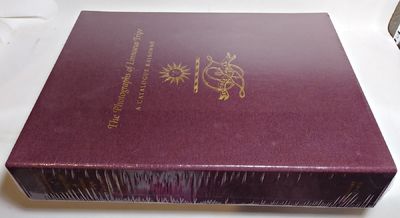
THE PHOTOGRAPHS OF LINNAEUS TRIPE. A Catalogue Raisonné
Dewan, Janet Toronto, 2003 Toronto: Art Gallery of Ontario, 2003. Pp. xv, 782, richly illustrated, maps, ports. Includes index and bibliographical references: [761 - 771]. Gilt-stamped maroon silk cloth, housed in a matching maroon cloth slipcase. Designed by Glenn Goluska. As New, still in publisher's shrink wrap and carton. The catalogue raisonné on the complete works of British photographer Linnaeus Tripe (1822-1902). His extraordinary images of architecture and scenic sites, made from calotype negatives, are among the most bold and inventive images realized in the early decades of photography. His training as a military surveyor, where the choice of viewpoint and careful attention to visual details were essential, gave his photographs a striking aesthetic rigor that distinguishes them from the picturesque travel views characteristic of the period. [Heavy book - 4kg. Please enquire about shipping fee]. Limited, First Edition of 500 copies. Hard Cover in Slipcase. As New.. Stout Quarto.- $313
- $313
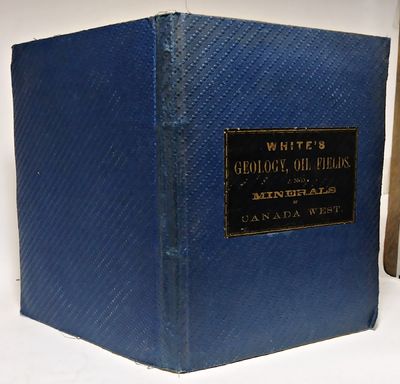
GEOLOGY, OIL FIELDS, AND MINERALS, of Canada West: How and Where to Find Them … Geological Maps of Canada West and of the Oil Regions … with a Copious Glossary, Index and a Catalogue of 42 Different Mineral Species …
White, Henry Toronto, 1865 Toronto: W.C. Chewett & Co., 1865. 16.3 cm x 12.8 cm, pp. 109, 2 very large, colour folding maps, original textured blue cloth boards, gilt-titled on a black panel. Covers slightly worn, else a very good plus copy. White, d. 1879, was a provincial land surveyor. TPL 4461. First Edition. Hard Cover. Very Good Plus.. 16 mo..- $742
- $742
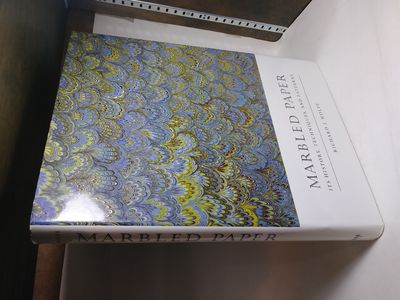
MARBLED PAPER, Its History, Techniques, and Patterns with Special Reference to the Relationship of Marbling to Bookbinding in Europe and the Western World
Wolfe, Richard J. Philadelphia, 1900 Philadelphia: University of Pennsylvania Press, 1900. A Publication of the A.S.W. Rosenbach Fellowship in Bibliography. 30.5 cm x 23 cm, pp. xvi, 245, richly illustrated in colour and black & white. Navy blue cloth, gilt spine lettering. Fine, as new copy in fine, as new dust jacket. . First Edition. Hard Cover. Fine/Fine. Small Folio.- $410
- $410
![ALICE'S ADVENTURES IN WONDERLAND. With 96 Illustrations by George Walker [and] ALICE'S ADVENTURES IN TORONTO. The Wood Engravings and Drawings for Alice's Adventures in Wonderland by George Walker](https://rarebookinsider.com/wp-content/uploads/2023/07/1121131534.0.l.jpg)
ALICE'S ADVENTURES IN WONDERLAND. With 96 Illustrations by George Walker [and] ALICE'S ADVENTURES IN TORONTO. The Wood Engravings and Drawings for Alice's Adventures in Wonderland by George Walker
Carroll, Lewis. Introduction by Joseph A. Brabant Toronto: The Cheshire Cat Press, (Printed at the Poole Hall Press in Grimsby) 1988, 1991 Alice's Adventures in Wonderland: Unbound boxed copy, #41 in an edition of 177 copies, inscribed on the half-title to "Hugh Anson-Cartwright with best wishes from Joe Brabant 19.xii.88." includes the 4-page illustrated prospectus. 95 wood engravings cut by George Walker, including tipped-on hand-painted frontispiece on hand-made paper, signed in pencil and numbered 115/200. All enclosed in original maroon, cloth-covered clamshell box with gilt spine lettering, fine. TOGETHER WITH: Alice's Adventures in Toronto: #77 in an edition of 177 copies, inscribed on the half-title to "Hugh Anson-Cartwright with best wishes from Joe Brabant 2.5.92." 28.5 cm x 20.5 cm, printed on Japanese folded sheets (double-fold), Contains George Walker's 'Alice' engravings, engravings that were not used and the reasons for not using them, and Walker's preliminary sketches. Plain brown cloth spine over beige boards illustrated with the cheshire cat, no jacket as issued. Fine, as new copy. . Inscribed. Limited Edition. Unbound Boxed Copy / Hard Cove. As New. Quarto.- $1,172
- $1,172
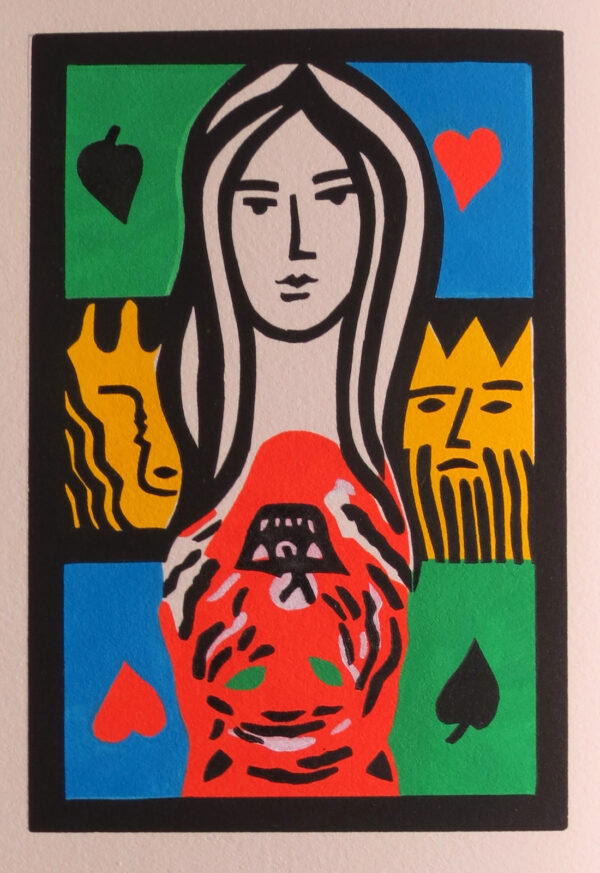
The Lady or the Tiger
Stockton, Frank L. 6 x 9. Approx 28 pages. Two pochoir frontispieces in six colors, & a dozen small, single color drawings by Walter Bachinski of the Shanty Bay Press. Bound tete-beche in quarter cloth, slipcase. Fine. These are two stories about "ambiguity and living in a society ruled by arbitrary justice." No. 17 of 30 copies printed letterpress in Weiss and American Uncial on handmade Batcham Green paper. Signed by the artist.- $920
- $920
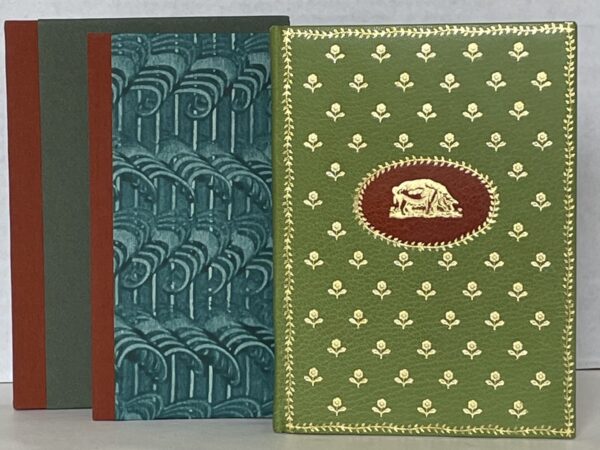
Seasons from Nicholas Breton’s ‘The Twelve Moneths’ written in 1626
Connors, Sandy 5 1/2 x 7. (14) pages. Full green morocco gold tooled with flowers & leaves; brown morocco insert with gilt pig on cover; marbled endpapers. A separate portfolio holds a printing of the 4 seasonal engravings, colored by the artists, signed & numbered. Both fine in slipcase. One of 5 special sets in this fine binding by Christopher Shaw. The edition was 20 special copies and 45 regular, uncolored copies in boards. Only 5 specials were for sale, the remaining specials were for the binder.- $518
- $518
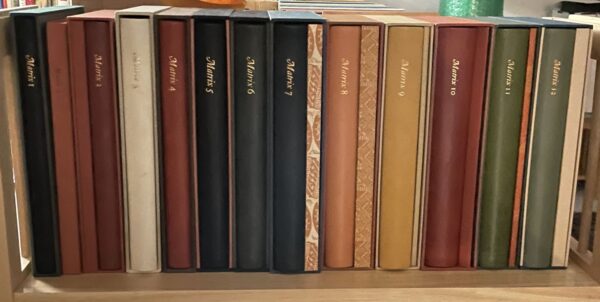
Matrix, A Review for Printers and Bibliophiles
Randle, John and Rosalind A mixed set of 38 volumes: Volumes 1- 36: Matrix 1 1985 reprint of 1981 Matrix 2 wraps regular 1982 Matrix 2 reprint deluxe 1993 Matrix 3 to 30 are all deluxe versions 1983-2012 Matrix 31 to 36 wraps regular 2012-2020 Plus deluxe Index for Matrix I to XXI. Except for Volume 2, the first 30 volumes are the deluxe issues with extra specimens, bound in morocco & marbled boards, slipcased. Beginning with Vol. 7 all the deluxe issues came with a separate portfolio of specimens. All are in fine condition. A treasure-trove of interesting material on private presses, wood engraving, type design, papermaking & decorated papers, letterpress printing, richly illustrated with numerous inserts and specimens. "Matrix is by now so well established," wrote Sebastian Carter in 2012, "that there is a danger that we may take it for granted. People in the future will look back in amazement at its riches. The majority of its illustrations are not reproductions, but the real thing. It is like visiting a group of collectors who keep bringing treasures out of drawers for our inspection --which we are then allowed to keep." See Parenthesis 44, pages 18-25.- $17,250
- $17,250
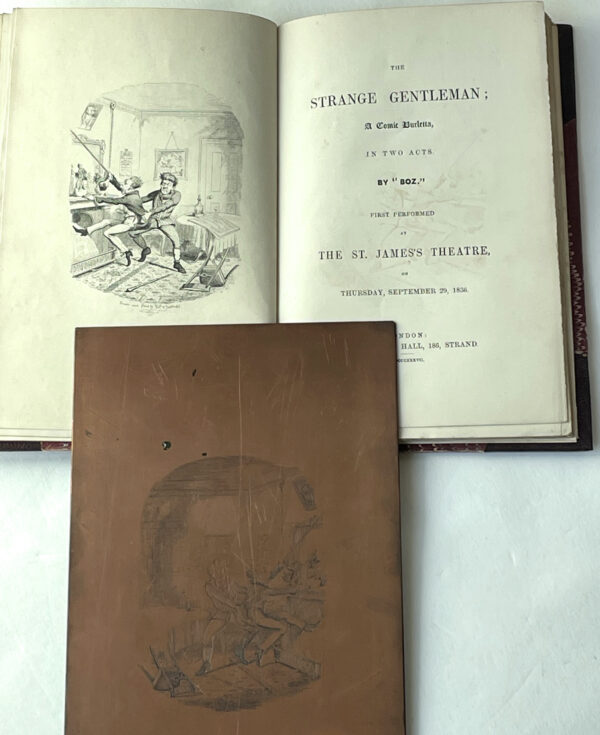
The Strange Gentleman
Dickens, Charles 5 x 7 1/2. Frontis, 46 pages, (1) ad. Original printed wraps bound into half morocco & marbled boards, matching endpapers. Bookplate of Vivian L. Henderson. WITH Pailthorpe's original copper-engraved plate (canceled) for the frontispiece. The plate measures 9 x 5., with image is 4 x 3. The plate has been canceled. The book is in very good+ condition. According to Eckel, copies of the 1871 edition with the frontis are particularly rare, as the illustration was evidently drawn and etched by the artist after the book was published. The etching was sold separately. The Morgan Library has Pailthorpe's watercolor drawing for this frontispiece.- $1,380
- $1,380
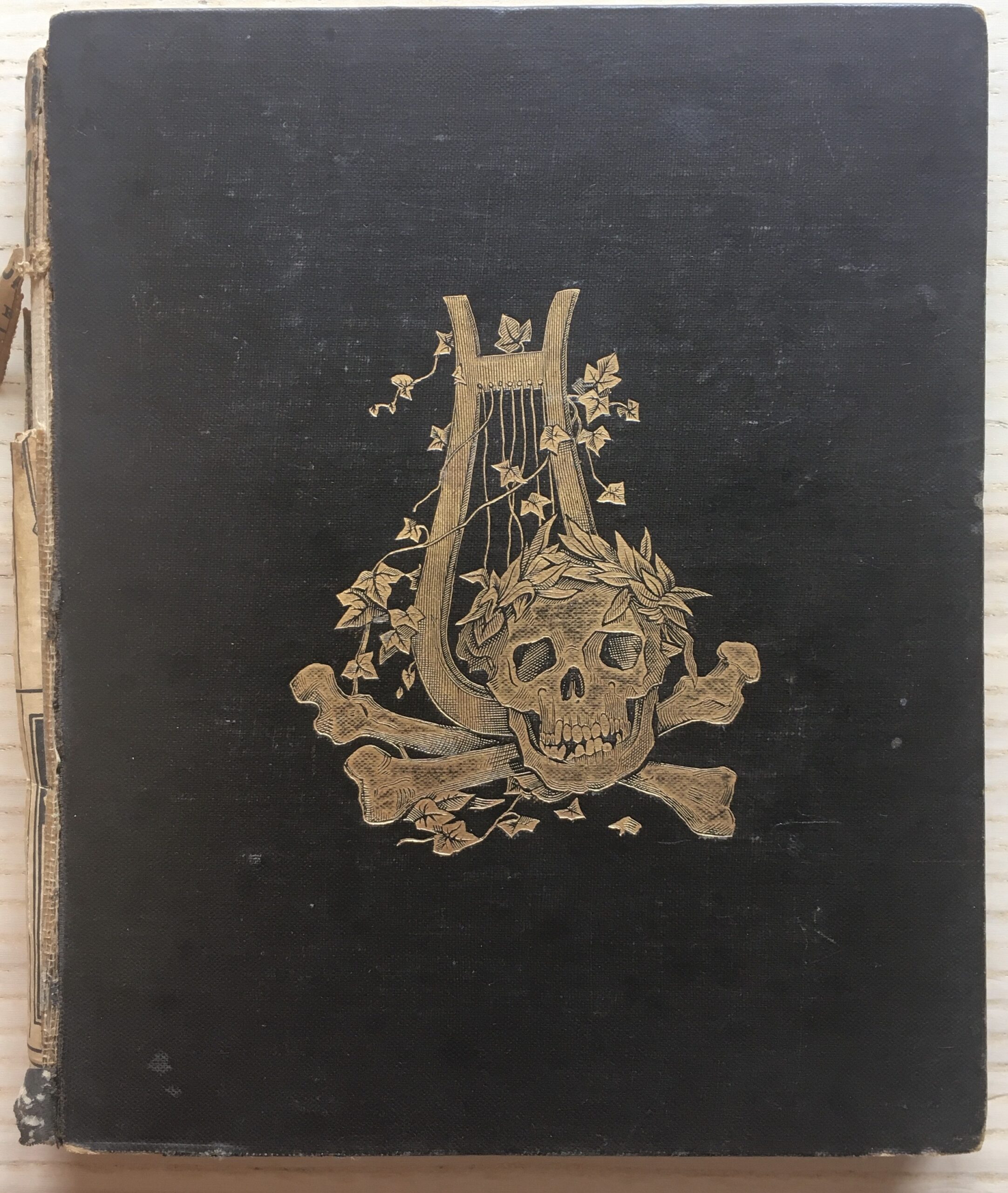
Flowers of Passion
Moore, George Black cloth covers with a stunning gilt design of skull and cross-bones with a lyre to upper board and all edges gilt. A little fragile with the spine missing and water mark to rear board, rubbing/scuffing to edges and corners but with upper board in very good condition, making it ideal for restoration. Internally clean with sporadic light marks to pages and marks to top corner of last 3 pages. ii, 114pp plus 2 pages of ads. 'Often regarded as first great modern Irish novelist, George Moore (1852-1933) influenced James Joyce among many others. While living in Paris he self-published his first book, The Flowers of Passion, a collection of lyric poems. The poems were derivative, and were maliciously reviewed by the critics who were offended by some of the depravities in store for moralistic readers. The book was withdrawn by Moore not long after publication'.- $257
- $257
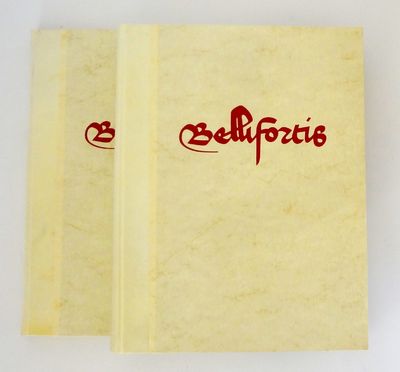
Bellifortis
Kyeser. Conrad London, New York, 1968 Two volumes in original glassine in plain slip case. Hard covers. Quarto. Half vellum with titles in red. Volume one is a facsimile of the original with 173 diagrams. Volume two is a translation into German of the original Latin text. Small mark to spine of volume one. Very good. Bellifortis ("Strong in War", "War Fortifications") is the first fully illustrated manual of military technology, written by Konrad Kyeser and dating from the start of the 15th century it summarises material from classical writers on military technology, like Vegetius' De Re Militari and Frontinus' anecdotal Strategemata, emphasizing poliorcetics, or the art of siege warfare, but treating magic as a supplement to the military arts; it is "saturated with astrology", remarked Lynn White, Jr. in a review of the first facsimile edition. Bellifortis was written in Latin and contained many elaborate illustrations of war weaponry. The manual discusses machines and technology that were old and new. It described weapons such as trebuchets, battering rams, movable portable bridges, cannons, rockets, chariots, ships, mills, scaling ladders, incendiary devices, crossbows, and instruments of torture] The portrait of the author is called by its modern editor the first realistic portrait of an author since Antiquity. Many of the illustrations for the book were made by German illuminators who were sent to Eichstätt after their own ousting from the Prague scriptorium.- $500
- $500
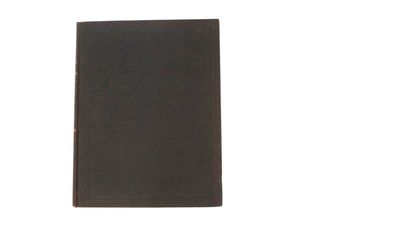
Report on the Geology of the Henry Mountains
Gilbert, G.K. and Powell J.W. Washington D.C., 1880 Second edition. Hard cover. Quarto. Dark brown cloth over boards with gilt to spine. [xii] 170 plus five fold out plates, one in color. Illustrated throughout with b/w drawings. Slight change of color to gilt on spine otherwise near fine.- $250
- $250
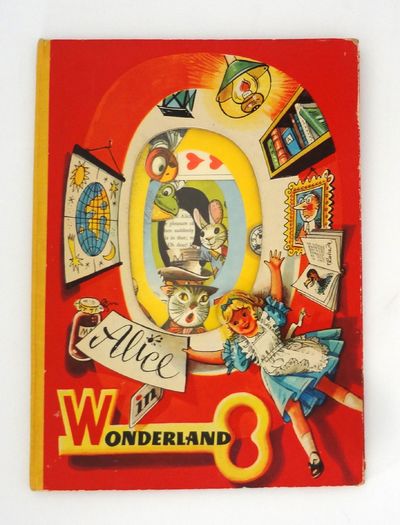
Alice in Wonderland (Pop-up Book)
Carroll, Lewis Westminster London, UK, 1960 Illustrated by Vojtech Kubasta. Hardcover. Tall quarto. Unpaginated but 18 pages and two double page color pop-ups on the end papers. Pictorial paper over boards with cloth binding. Front cover has a transparent plastic window with the next four leaves having smaller and smaller cut outs to create the appearance of looking into a tunnel. Full color illustrations to the head of each page. Small closed tear to bottom edge of two text pages. Light shelf wear to covers with some rubbing to edges otherwise very good. Pop-ups intact and in near fine condition. Vojtech Kubasta trained as an architect and became one of the most innovative paper engineers and artists of the 1950s and 60s. Working for the Czechoslovakian state publisher Artia he raised the standard for moveable books everywhere.- $600
- $600
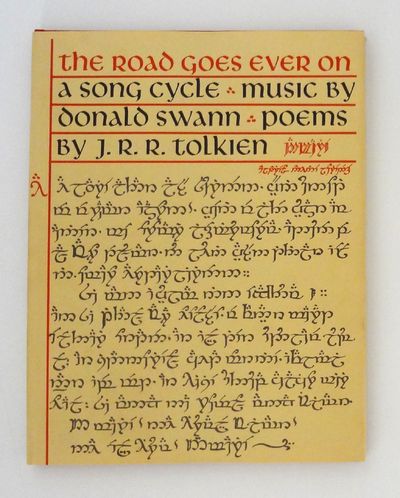
The Road Goes Ever On
Tolkien J.R.R. (Poems), Swann, Donald (Music) Boston, 1967 Stated First Printing. Hard cover. Slim quarto. 67 pages. Contains seven songs, six from "The Lord of the Rings" trilogy and one from "The Adventures of Tom Bombadil" along with a glossary of Elvish terms used in the songs. Illustrations by J.R.R. Tolkien and Samuel Hanks Bryant. Fine in a near fine dust jacket. This book has been valued even by those uninterested in music, since it helps Tolkien's readers to better understand the cultures of the various mythological beings presented in Middle-earth, and helps linguists analyse Tolkien's poetry. As well as the poems, notes, and translations, Tolkien contributed decorations in the form of Elvish script for the top and bottom of every page of sheet music, and tailpieces for the spaces at the ends of the poems. - Tolkien Gateway.- $375
- $375

N.C. Wyeth
Allen, Douglas New York, 1972 First Edition. Number 26 of a limited edition of 250 copies Signed by both Authors. Quarto. 335 pages. Half bound leather over cloth covered boards. Top edge gilt. Fine in a very good slip case. More than 300 color and black-and-white illustrations by one of America's preeminent painters are collected here, along with illuminating text from the artist's letters, magazine articles about his work, and many other sources. The result: a fully realized portrait of a "golden age" illustrator. - Goodreads.com- $300
- $300
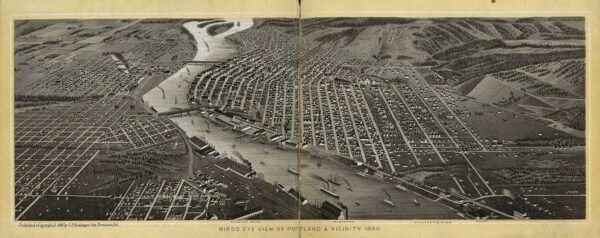
Souvenir of Portland Oregon, & Vicinity.
OREGON - PORTLAND) Accordion fold viewbook, 17 single-page illustrations and 1 double-page illustration in black and white, 5 x 6 inches, decorative debossed paper-covered boards with cloth spine. Covers worn and faded; splits to head and tail of outer spine repaired with tape at tail; many fold lines have short splits at the tail; the double page birds eye view illustration of the city has been repaired on the verso and is now detached from the following sheets of single page illustrations which are in overall very good condition on slightly glossy paper. The views are street scenes or montages of city buildings and natural scenery. Many buildings have since been demolished, including the Hotel Portland, the Marquam opera house, and Oregon Pottery works. A birds eye view shows a sparsely populated city with fields and trees where neighborhoods now exist. Five OCLC listings: California Historical Society, UC Berkeley, Multnomah County Library, University of Oregon, and Seattle Public Library.- $152
- $152
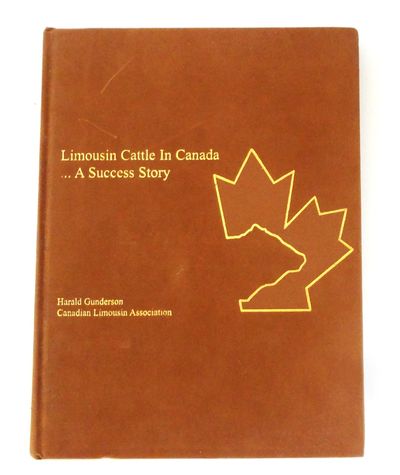
Limousin Cattle in Canada…A Success Story
Gunderson, Harald Calgary, AB, 2002 Inscribed and signed by the author to Dale F. Runnion who contributed the foreword. Hard cover. Brown suede with gilt title and design. Quarto. 208 pages. A few faint marks to the suede cover otherwise very good throughout.- $125
- $125
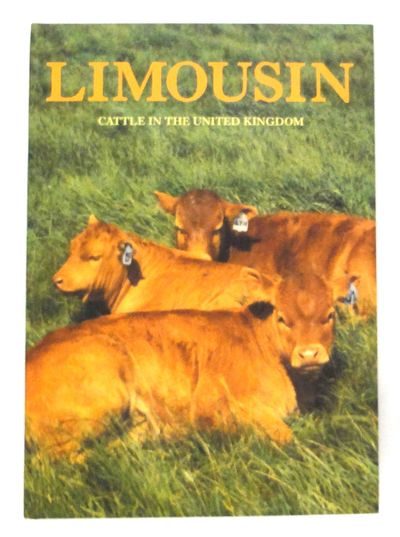
Limousin Cattle in the United Kingdom
Jobst, Dieter East Molesey, UK, 1986 Inscribed and signed by author on the half title page: With Good Wishes to an / "Old" Limousin Friend / Dieter Jobst / September 1986. Pictorial hard cover. Quarto. 192 pages. Clean and unmarked. Tight binding. Very good condition.- $125
- $125
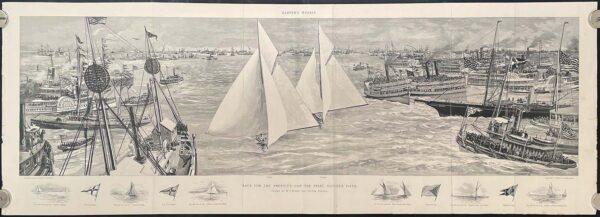
Race for the America’s Cup – The Start, October Fifth.
YACHTING - AMERICAS CUP) Burns M. J. and Victor Perard (illus). Large wood engraving 12 x 42 inches with ten vignettes along lower margin, sheet size 16 x 44 1/2 inches, folded as issued, Harper's Weekly, October 14, 1893. Tiny chips and short tears (up to 3/4 inch) to left and right margins, outside image area; pinhole to lower margin at centerfold; overall very good condition. Gorgeous capture of The America's Cup. Main image includes sailboats Vigilant and Valkyrie centered among various ships filled with excited spectators. Includes ten vignettes of the ship's flags, dated/timed imagery detailing the Vigilant and Valkyrie's progress along the race, and the flags of "R.Y.S. Burgee." and "N.Y.Y.C. Burgee." Published as a foldout supplement in Harper's Weekly magazine, October 1893.- $184
- $184
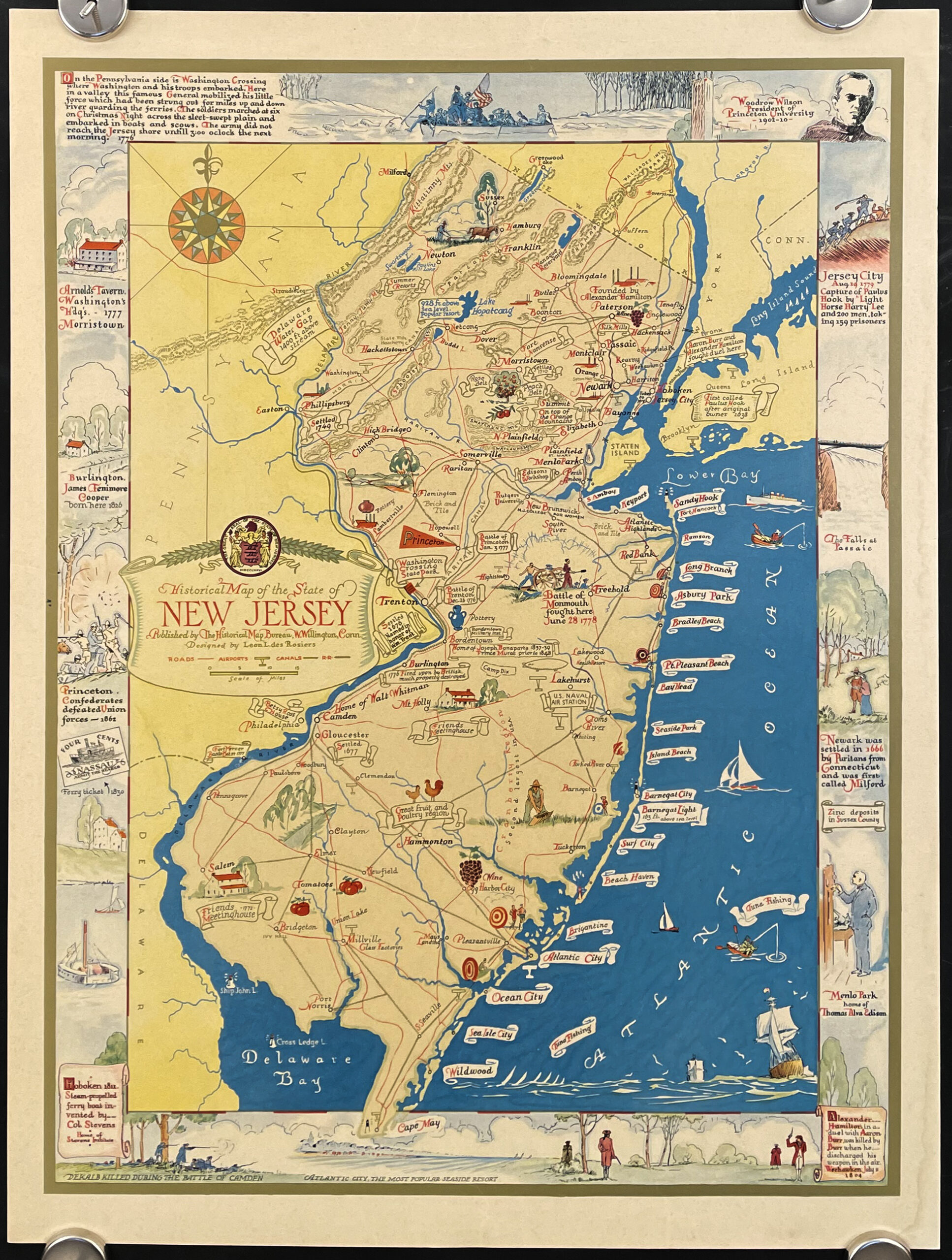
Historical Map of the State of New Jersey.
NEW JERSEY) des Rosiers, Leon L. (illus). Color pictorial map, 22 x 16 5/8 inches on sheet 24 x 18 inches. Two inch tear to mid right margin (archivally repaired and scarcely visible from recto/front of sheet. Light edge wear to sheet. Clean, bright image. Displays handsomely. Brightly colored, most attractive map by Leon des Rosiers with a border showing historical events and places, and pictographs on the map showing attractions and products eg. wine at Egg Harbor City, the Cranberry Region, Pottery etc.- $173
- $173
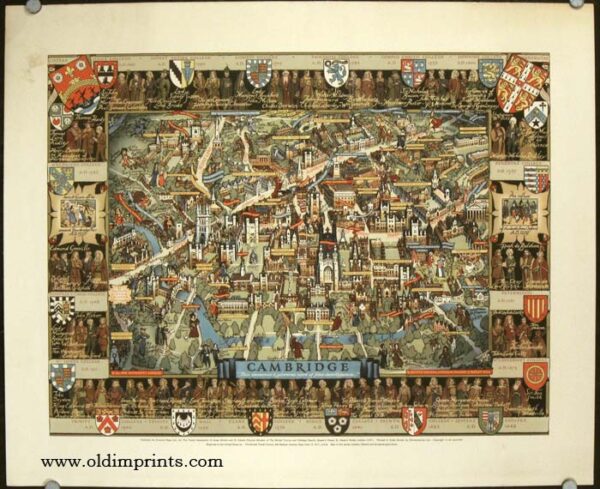
Cambridge. “This immense & glorious work of fine intelligence.”
ENGLAND - CAMBRIDGE) Lee, Kerry (illus). Color pictorial / pictographic map, image 17 1/2 x 22 3/4 inches on sheet 22 x 27 inches. Light soiling to upper left margin. Mended tear to lower left margin, overall very good condition. Highly detailed and colorful vintage poster of the University of Cambridge campus illustrated by Kerry Lee.- $578
- $578
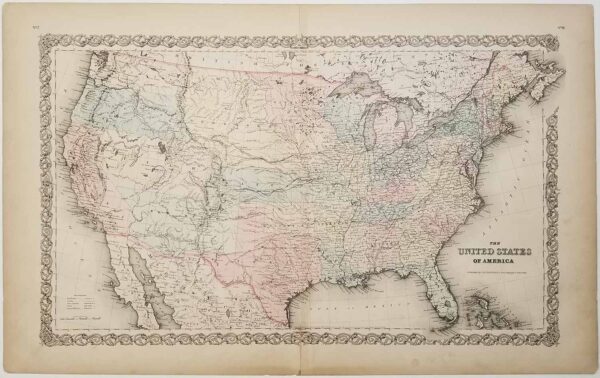
The United States of America.
UNITED STATES) Map, handcolored, 15 1/2 x 26 inches including decorative border on sheet 18 1/2 x 30 inches (wide margins), centrefold. Light soiling (including a couple of finger prints) and toning to margins, centrefold has been taped on verso with split to two ends of centrefold just entering lower edge of map at the lower edge, one tiny repaired tear at upper border, shape of Illinois has been traced, but this is only visible under raking light from verso; map would display very well. Very large Washington, Oregon (stretching from the Pacific to the Rockies): Utah and New Mexico (stretching from California to Nebraska / Kanzas / Texas); Nebraska (stretching from the Rockies to Minnesota); Kanzas (sic) from the Rockies to Missouri. A wonderful map contrasting the large open territories of the West with the more densely settled East.- $152
- $152
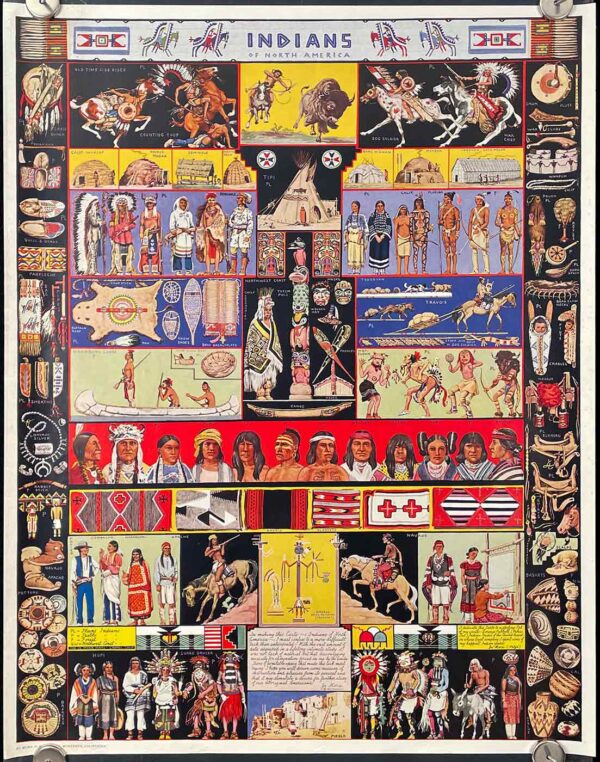
Indians of North America. VINTAGE COLOR POSTER.
JO MORA - NATIVE AMERICANS) Mora, Jo (illus). Color poster, 31 3/4 x 24 inches. Several small tight creases from rolling, creasing to margins; very light foxing to left margin; image area in overall very good condition. Poster - probably 1950s edition. "Jo Mora Publications, Monterey, California" in lower left corner. Wonderful rich coloration.- $473
- $473
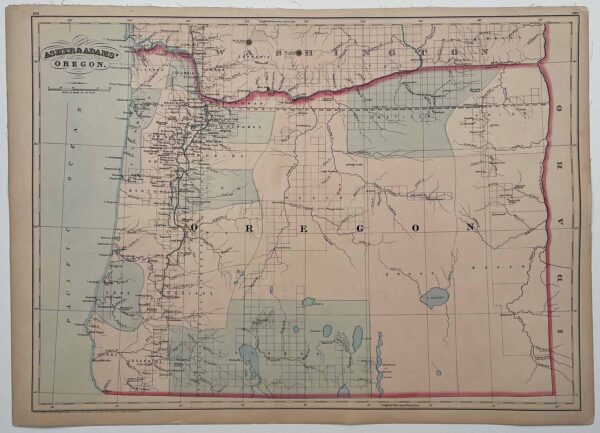
Asher & Adams’ Oregon.
OREGON - ca. 1874) Map on cloth backing, original handcolor, 16 x 22 1/2 inches on sheet 17 1/4 x 24 inches, NEVER FOLDED. Light general toning; small chips to right corners and 2 x 1/8 inch abraded strip along right edge, all well outside map area and minimized by backing; very good condition. A detailed map of Oregon, with some interestingly inaccurate depictions of the physical geography of Oregon, which are corrected in late editions of the map. The survey grids indicate very little of the eastern portion of the state as having been surveyed. The Snake River above 45 degree latitude follows very closely the 117 degree of longitude line (corrected in later maps to show the wide curve of the river at this point); in Grant county Lake Harney is shown as a single large lake, whereas in later maps it appears with Malheur Lake.- $152
- $152
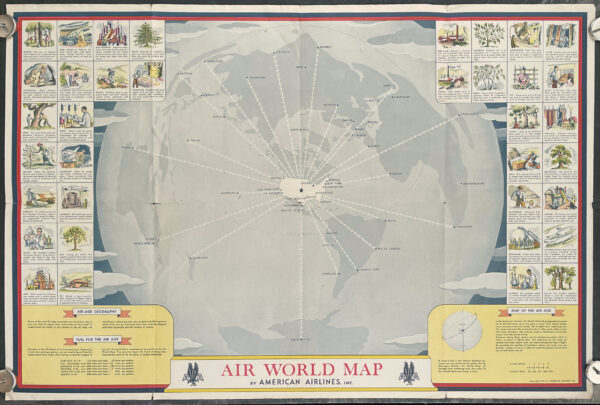
Air World Map. By American Airlines, Inc.
WORLD AVIATION MAP - WORLD WAR II - AMERICAN AIRLINES) Color poster, pictorial map, image 22 x 33 inches (56 x 84 cm) on sheet 23 x 34 inches, folding to 11 1/2 x 8 1/2 inches as issued. Soft general creasing, multiple splits to fold ends up to 3/4 inch, short splits at fold intersections (3/4 inch at left centre fold), good condition overall. This simple but graphically striking map is a fine example of the "air age" geography that was a hallmark of the late 1930s and 1940s in America. Mapmakers such as Richard Edes Harrison and Charles Owens employed new map projections to convey a more realistic sense of distance than the traditional Mercator projection allowed. In this map issued by American Airlines with the United States at its centre routes are represented by lines of airplanes: "The airplanes on the map are spaced 250 miles apart, each one representing one hour's flight. By counting the number of airplanes along any route, you can find the number of hours it takes to reach the places shown from the United States by air." The map is bordered by illustrations of products used in building airplanes: "some of the vital Air-Age materials are listed here.to understand the needs of our country in the Air age, we must know what materials are needed to build airplanes, where they can be obtained, how they may be shipped, and how accessible are the sources of supply." Under the heading "Fuel for the Air Age" is a listing of six plane types with speeds and number of miles per gallon flown, so that, at 10 cents per gallon, "you can easily figure.how many War Stamps would be needed to pay for the fuel to fly a warplane to any point on the Air World Map."- $257
- $257

Rockwell Kent – Beowulf: Genealogical Tree.
KENT, ROCKWELL) Kent, Rockwell (illus). Black and white lithograph, 12 1/2 x 10 inches on textured cream paper 16 x 12 1/2 inches, trim marks at upper edge. Light edgewear, light toning to outer right edge, a few faint marks to margins; overall very good condition. A man and woman sit in front of three broken trees representing the bloodlines of three Scandinavian tribes: the Danes, the Swedes, and the Geats. Rockwell Kent (1882 ? 1971) was an American artist and adventurer whose 1931 Beowulf illustrations accompanied the 1932 translation by William Ellery Leonard in a limited run of 950 copies. This original unsigned lithograph is the mirror image of the 1931 print and includes names, as published in the book. An attractive and dramatic image.- $368
- $368

Late Victorian scrapbook.
VICTORIAN EASTER CARDS) Hardbound scrapbook, unpaginated (46 pages), 15 x 12 3/4 inches, containing approximately 90 holiday cards, trade cards, and illustrations of various sizes, mostly chromolithographic. Paper covered boards, heavy gilded decorative pictorial embossed covers. Rubbing to cover spine and extremities, chipping to lower left corner of back cover, age toning to sheets, multiple tears, light wear and abrasions to some images; cards in good condition overall, bright and attractive. The theme that emerges is one of springtime, Easter, innocence, and Christianity. Cards depict Bible scenes, fruit, women and children, chicks, eggs, kittens, flowers, and doves; some magazine illustrations are also pasted in. The large size of the scrapbook allows for some unusually large items to be included. Most images are undated but some have the dates 1887, 1896, and 1898, and a calendar toward the end is for the year 1901. The scrapbook itself has a patent date of March 1876.- $152
- $152

The Four Freedoms. Painted by Norman Rockwell. WWII ERA PRINTS WITH ORIGINAL MAILING ENVELOPE.
ROCKWELL, NORMAN) Rockwell, Norman (illus). Four offset color lithographs, image area 13 3/4 x 10 3/4 inches on sheet 16 1/4 x 12 1/4 inches, WITH ORIGINAL MAILING ENVELOPE. Envelope: moderate wear and soiling with two 1 inch areas of paper loss, penciled name to verso. Prints: light edge toning, soft general creasing, slight bump to upper corners, tiny chip to lower right corner of Freedom to Worship print (well outside image area), 1/4 x 1/2 inch paper loss to left margin of Freedom from Want print (outside image area); overall good clean condition. The complete set of Norman Rockwell's most famous illustrations: Freedom of Speech, Freedom from Want, Freedom from Fear, and Freedom of Worship. Rockwell intended them for patriotic posters, but the Office of War Information wasn't interested. They were subsequently published by the Saturday Evening Post, and were so popular that in May 1943 the Post and the U.S. Treasury Department started a joint fundraising campaign by sending the original paintings on an exhibition tour. These prints appear to be souvenir of that tour -- an eagle printed at upper left on the enveope carried a sign reading "U.S. Treasury Department and Saturday Evening Post WAR BOND SHOW".- $788
- $788
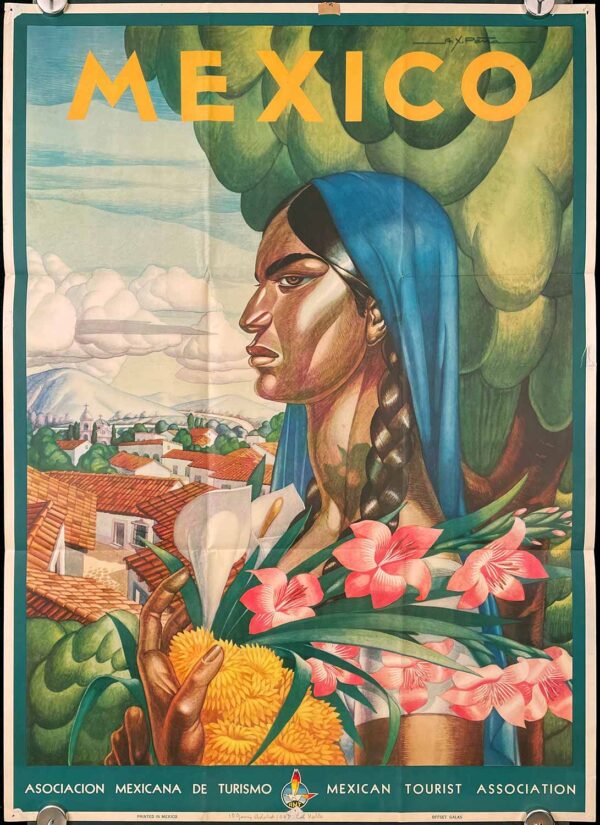
Mexico.
MEXICO TRAVEL POSTER) Peña, A.X. (illus). Vintage color poster, 36 1/4 x 26 1/4 inches, folding as issued to 12 x 8 3/4 inches. Pinholes, abrasions and/or short tears at margin corners and centers, slightly entering image border; paper residue to center upper margin; penciled address to center lower margin; green stain on verso shows up as green shadow on woman's neck (see detail image); otherwise very good bright condition; colorful image would display well. An attractive image of a woman standing proudly with an armful of flowers in front of a village. The artist, whose signature appears at upper right, was the Mexican painter Alfonso X. Peña (1903-1964). A photo of the original painting appeared in a 1936 El Nacional article in which the author wrote that Peña's "work is characterized by color that preserves all the lights and all the vibrations of the people and things that can be found in regions of the Republic, that is Tehuantepec, the mesa, the coast.?- $236
- $236
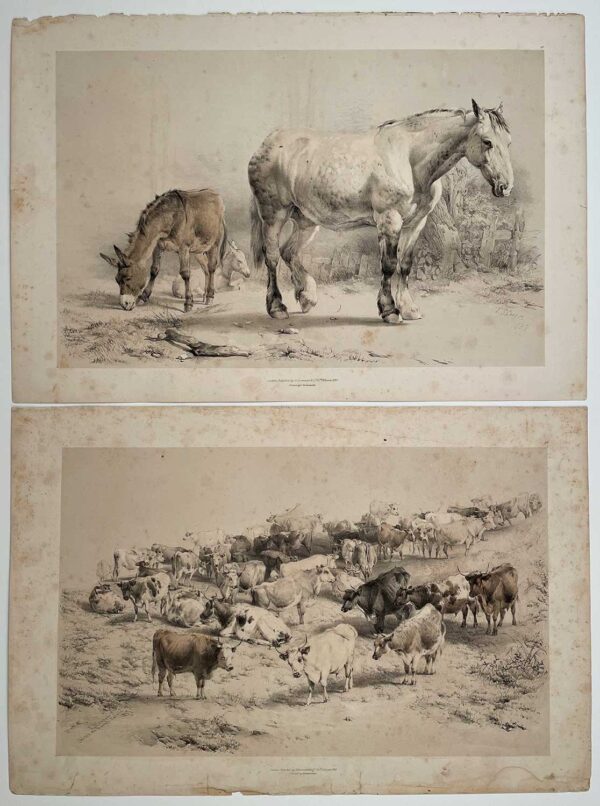
SEVEN LITHOGRAPHIC PLATES from “Groups of Cattle, Drawn from Nature.”
CATTLE - 1839 BRITISH ARTIST LITHOGRAPHS) Cooper, Thomas Sidney (artist). SEVEN lithographs with handcolor, approx 11 3/4 x 17 1/2 inches (sizes vary slightly) on sheets approx 14 1/4 x 21 inches (elephant folio). Binding holes to top edge of each sheet; foxing and light streaks particularly visible in margins and sky areas; multiple repaired edge tears, chipping and staining from water exposure to lower margin of one print (outside image area); diagonal score to left lower margin of four prints, just penetrating or outside image area. Despite faults, would display well. Thomas Sidney Cooper RA (1803-1902) was an English painter and lithographer who specialized in images of cattle and sheep. These delicate and expressive lithographs were printed by C. Hallmandel.- $257
- $257
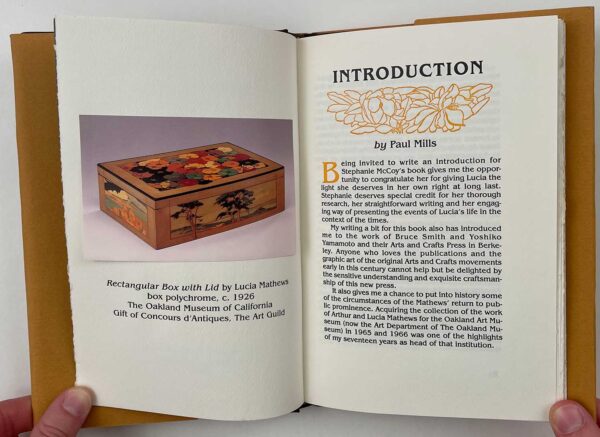
Brilliance in the Shadows: a biography of Lucia Kleinhans Mathews. LETTERPRESS BOOK.
ARTS & CRAFTS - CALIFORNIA) McCoy, Stephanie. Kleinhans Mathews, Lucia (illus). Hardbound book, illustrated in color and black and white, 47 pages, 8 x 5 1/2 inches, cloth-covered boards with pictorial dust jacket. White mark to back cover, two 1/8 splits to head of dust jacket spine, spine slightly slanted; overall very good clean condition. A beautifully produced book, letterpress printed and hand bound by The Arts & Crafts Press in Berkeley. Several of the illustrations are tipped in. Lucia Kleinhans Mathews (1870 - 1955) was a key contributor to the California Arts and Crafts style.- $131
- $131
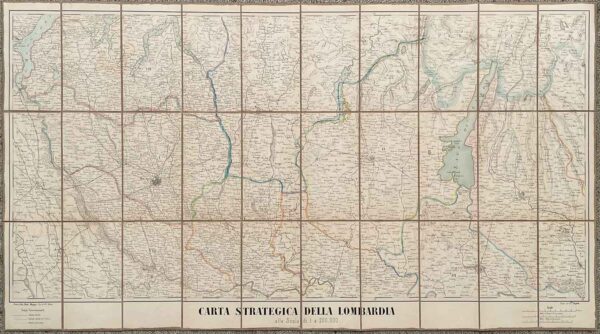
Carta Strategica Della Lombardia alla scala di 1 a 200,000. ANTIQUE FOLDING MAP.
ITALY - LOMBARDY ca. 1855 MAP) Doyen, Flli. (lithographed by). Map, lithograph with handcolor, divided into 30 panels on linen backing, 21 x 42 inches on sheet 23 3/4 x 43 inches, folding into marbled card case 8 1/4 x 5 inches. Rubbing to extremities of case, light general toning to map; very good condition. The map of Lombardy shows towns, roads, rail lines, woods, and rivers. Lake Maggiore is at the upper left and the marshland of Valli Grandi Veronesi is at lower right. Hatching indicates elevation, and province borders are emphasized with handcolor. A rare item with no OCLC record.- $415
- $415
